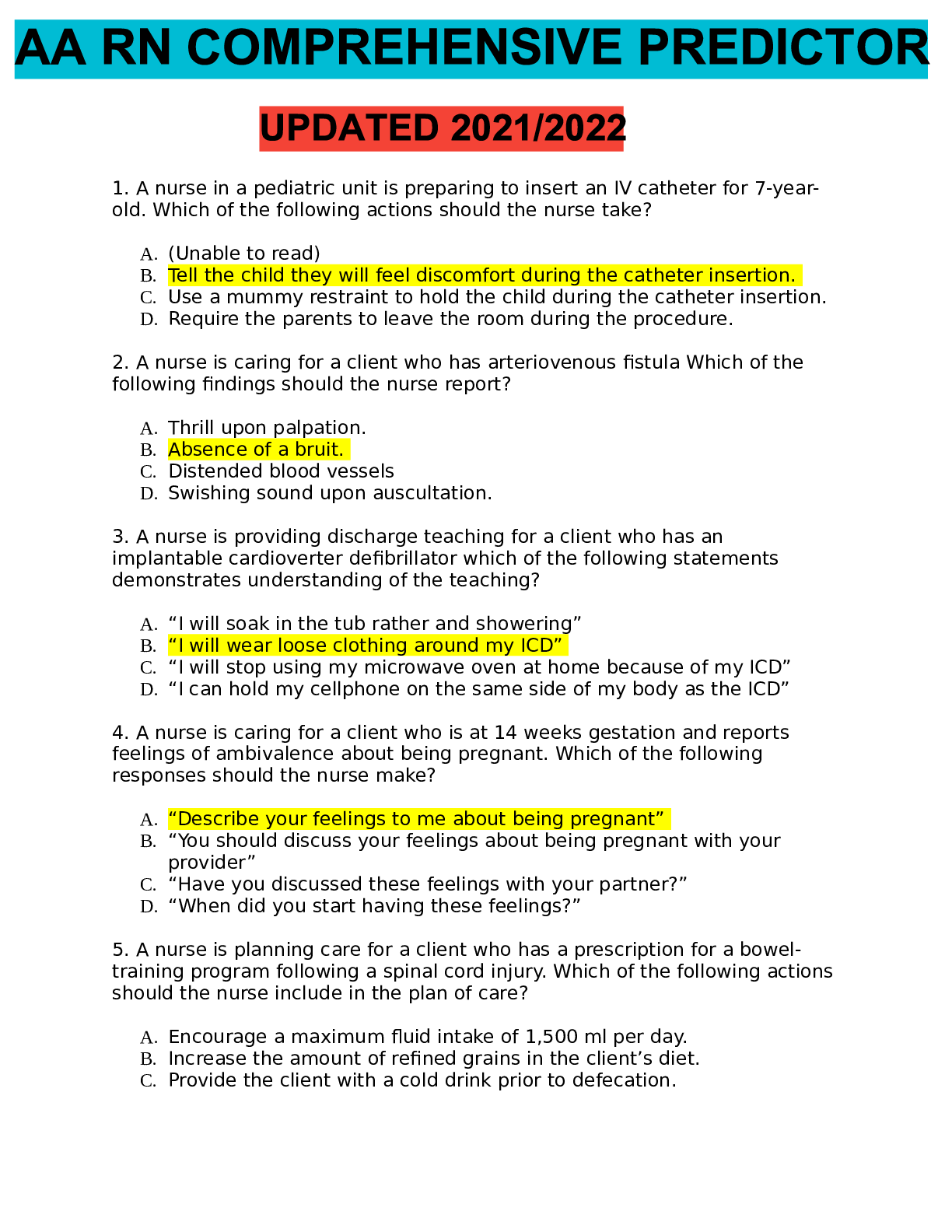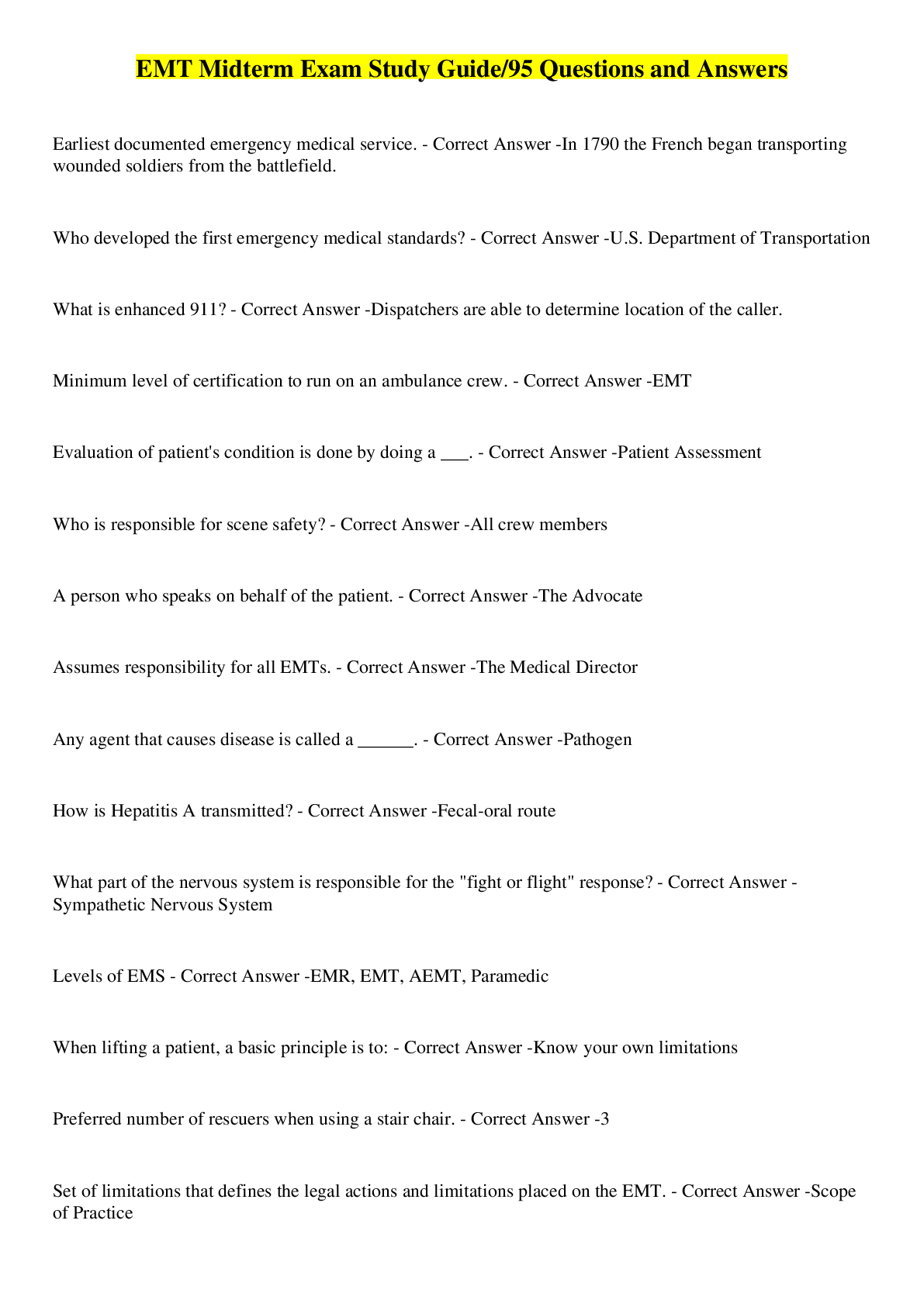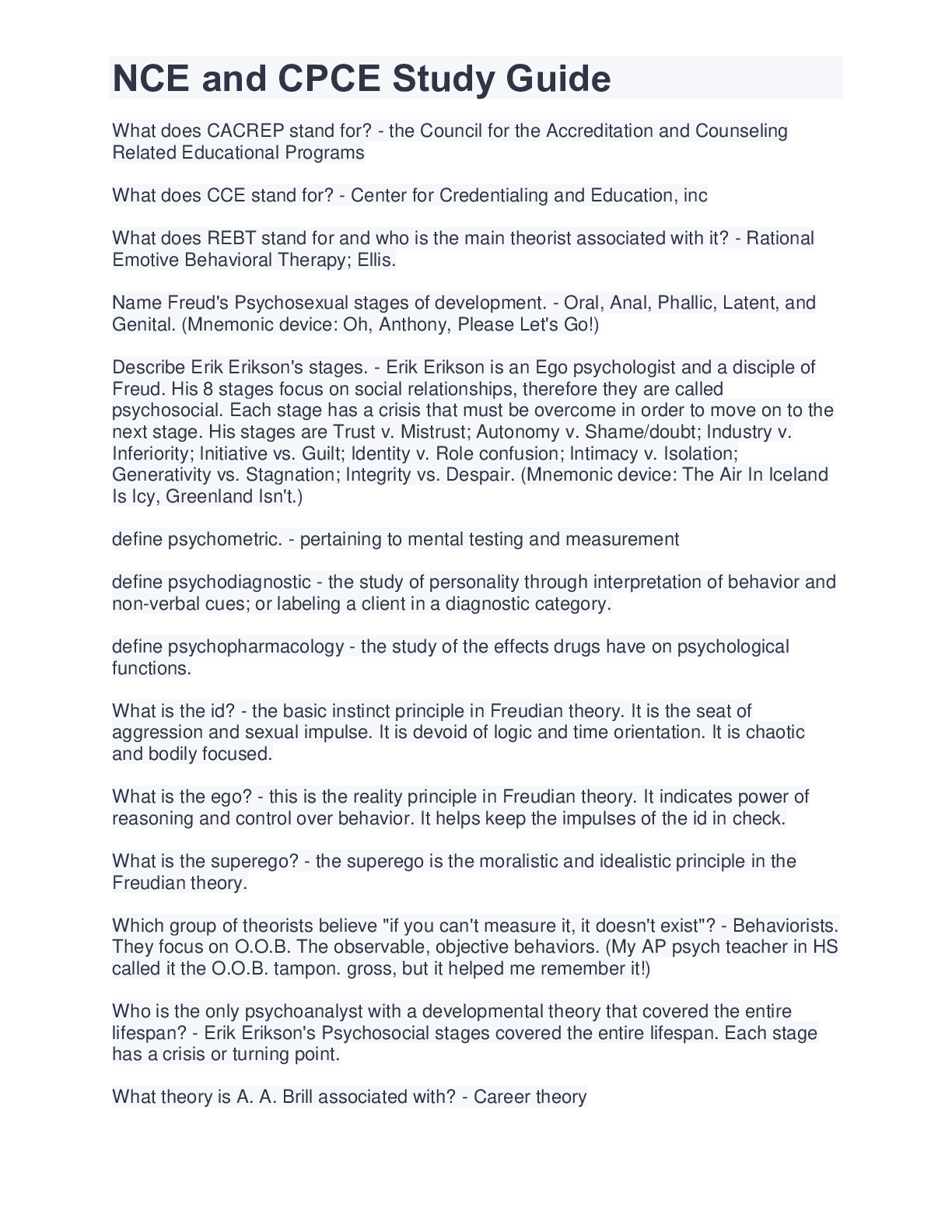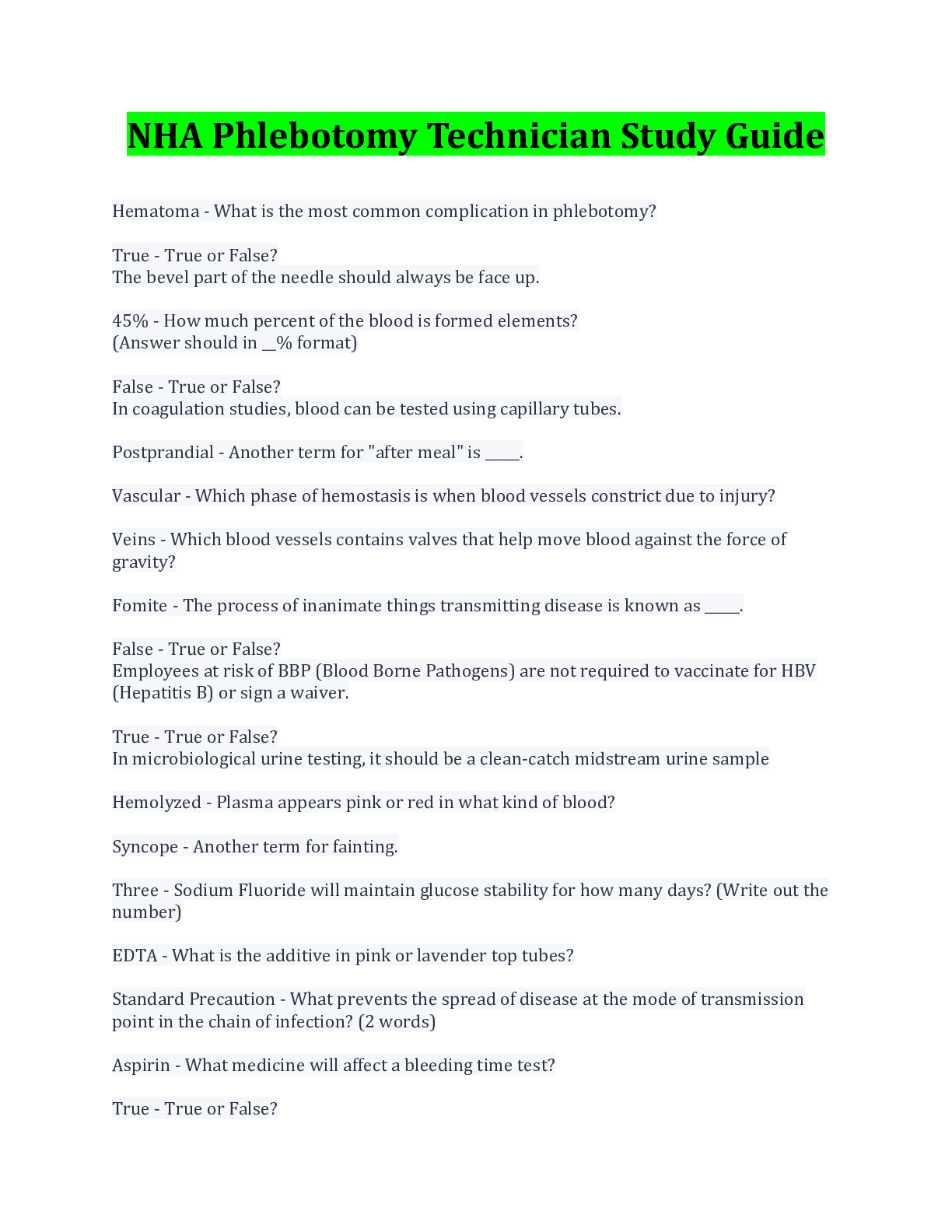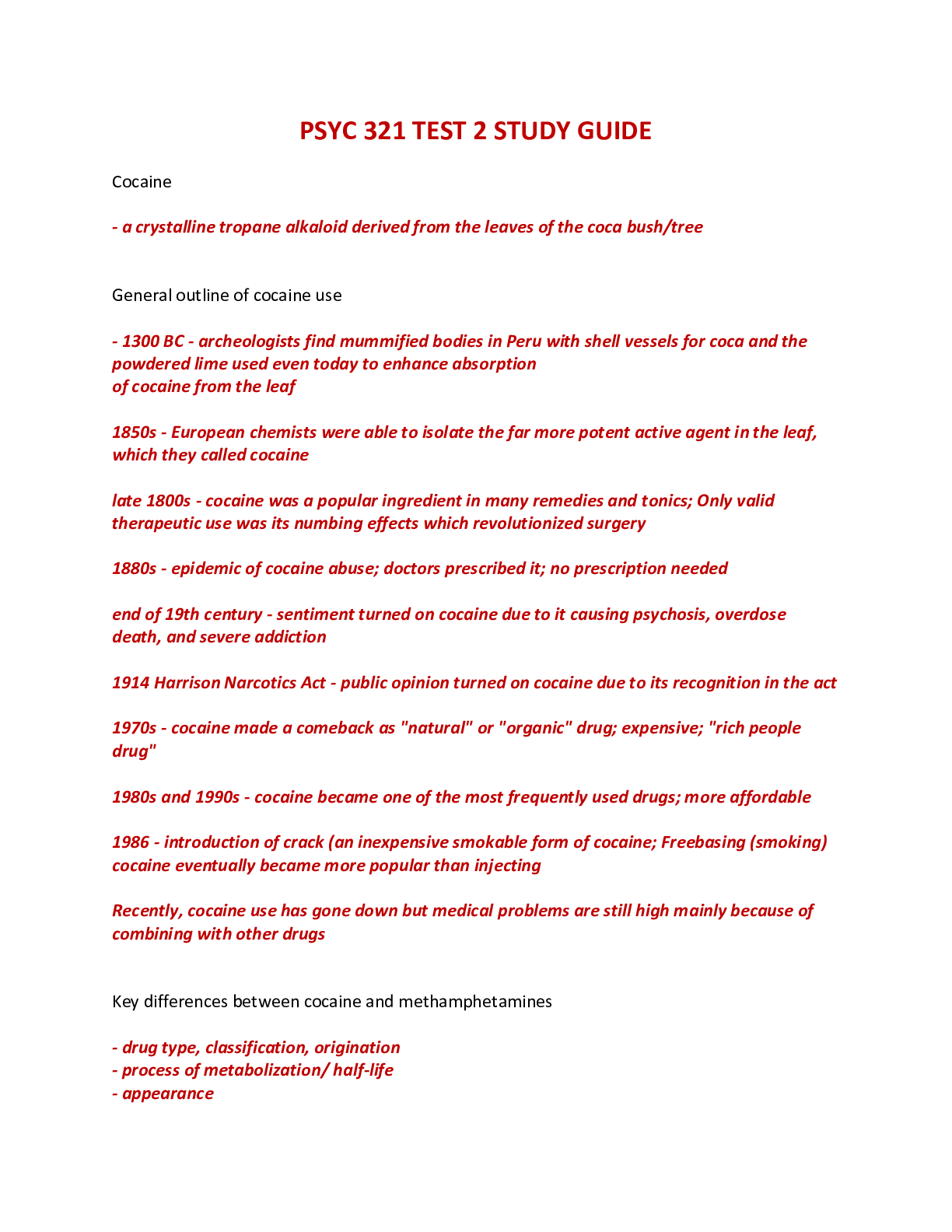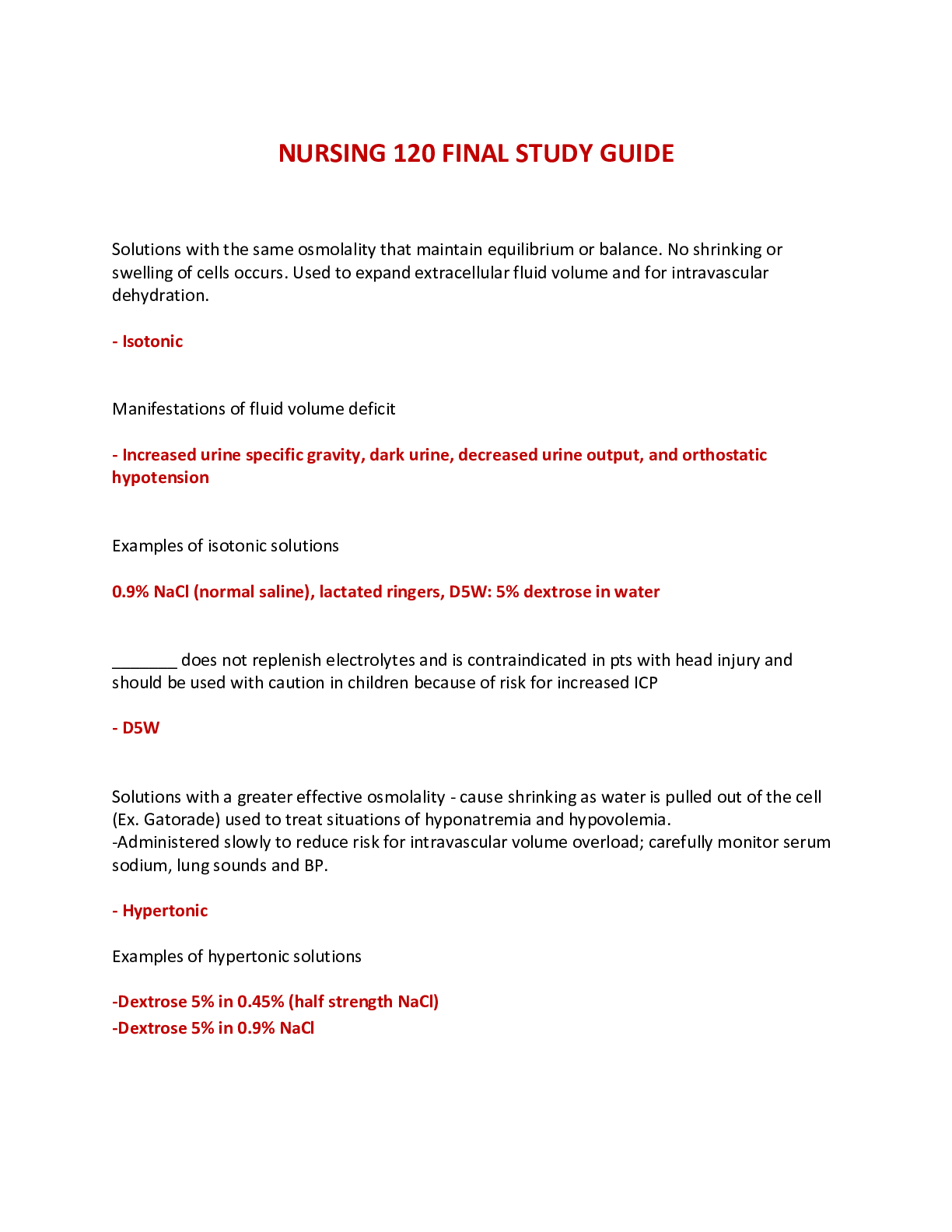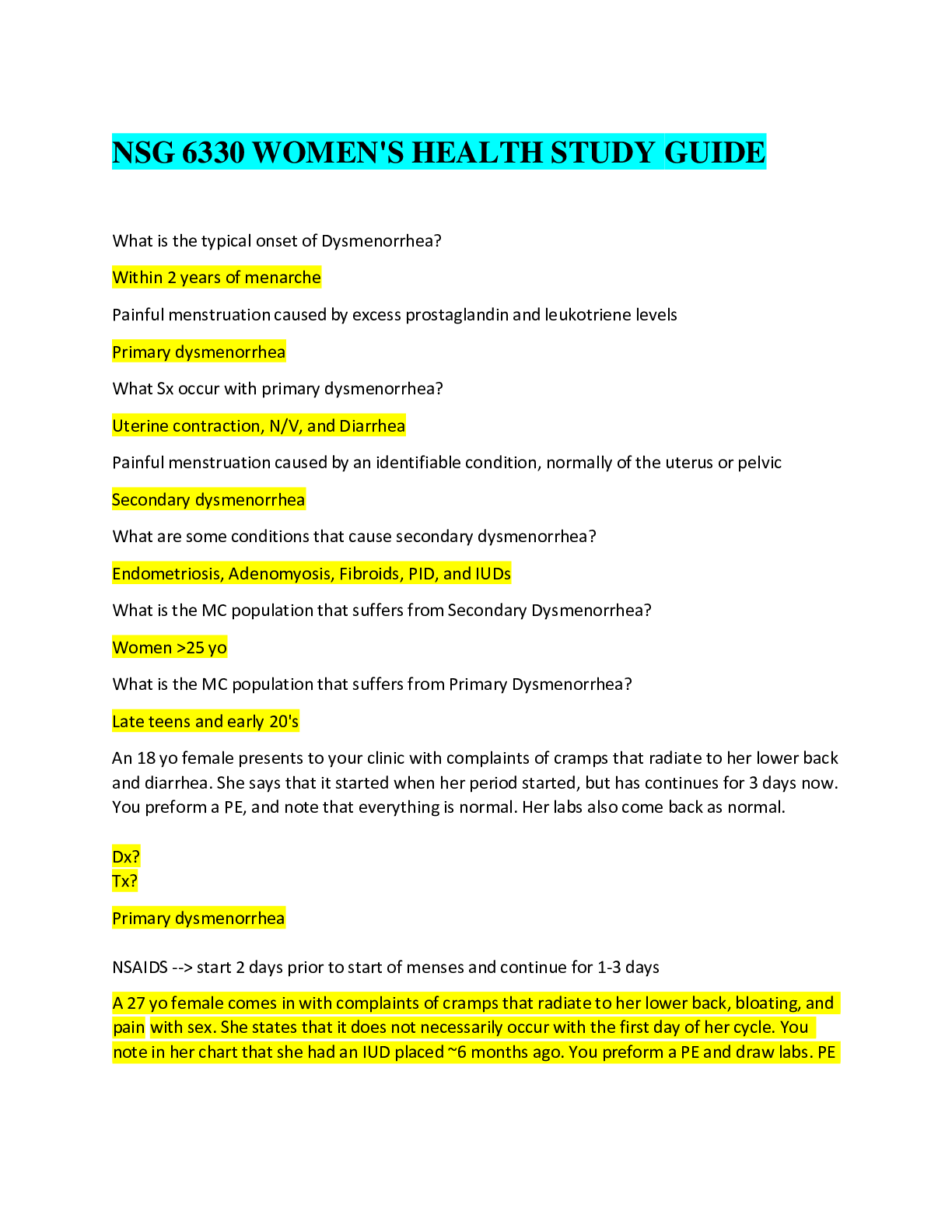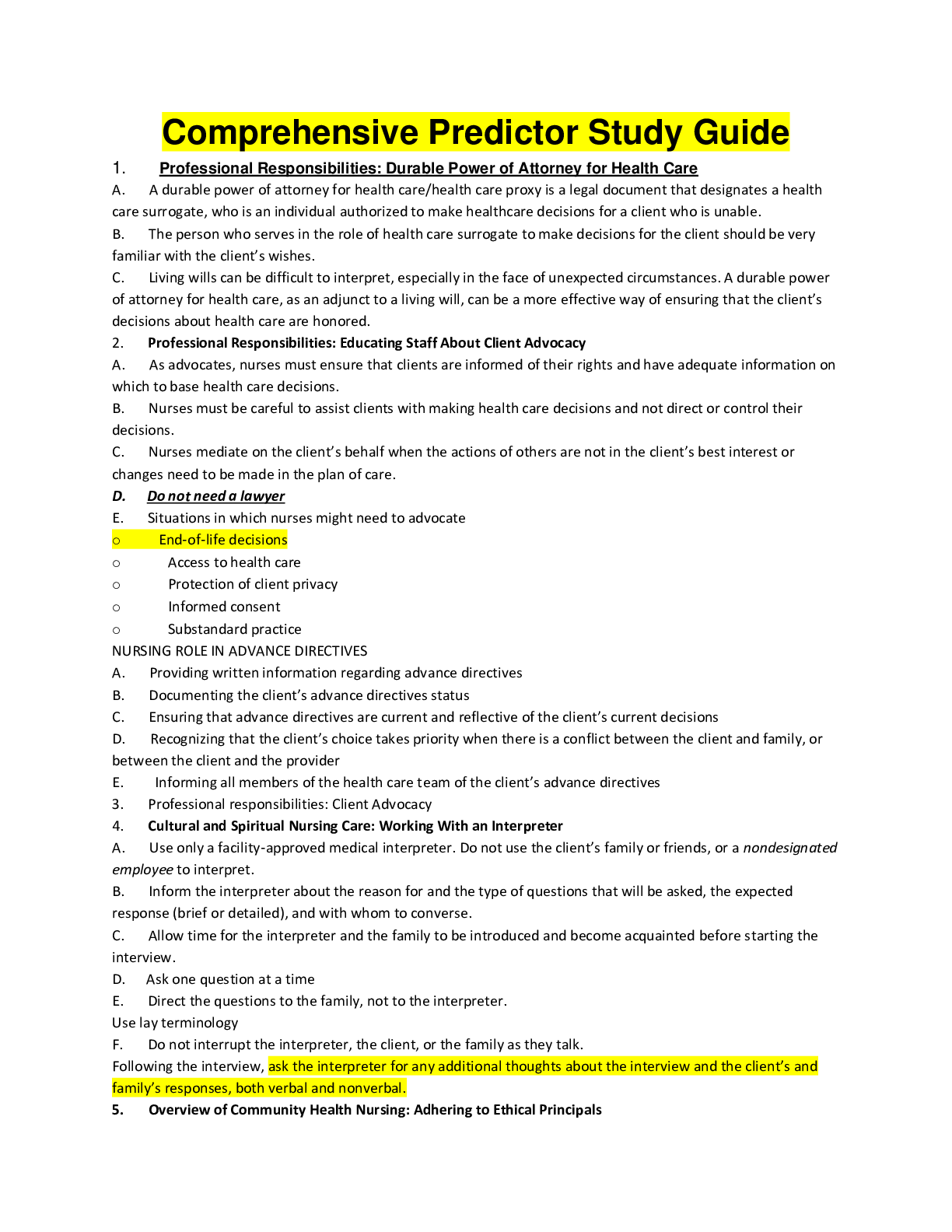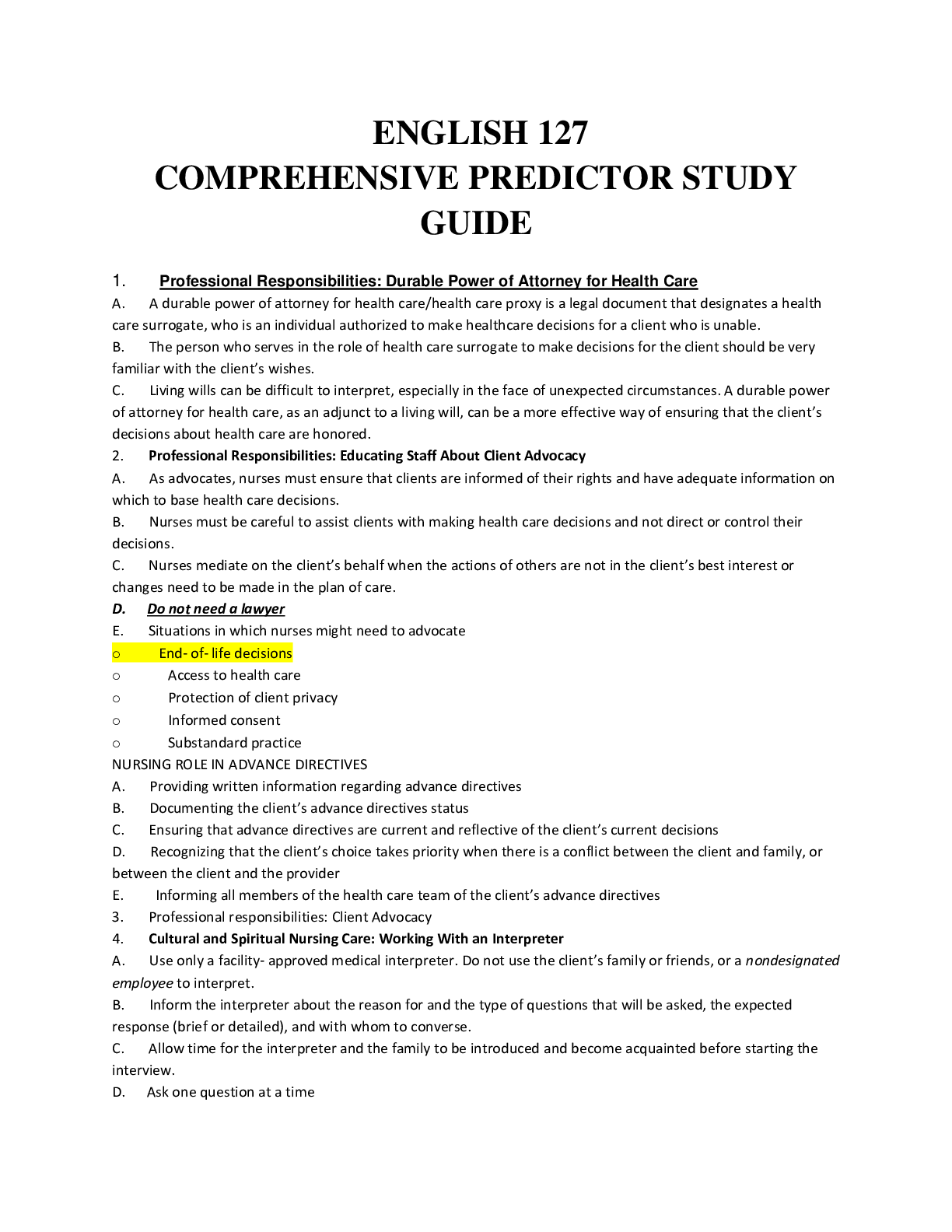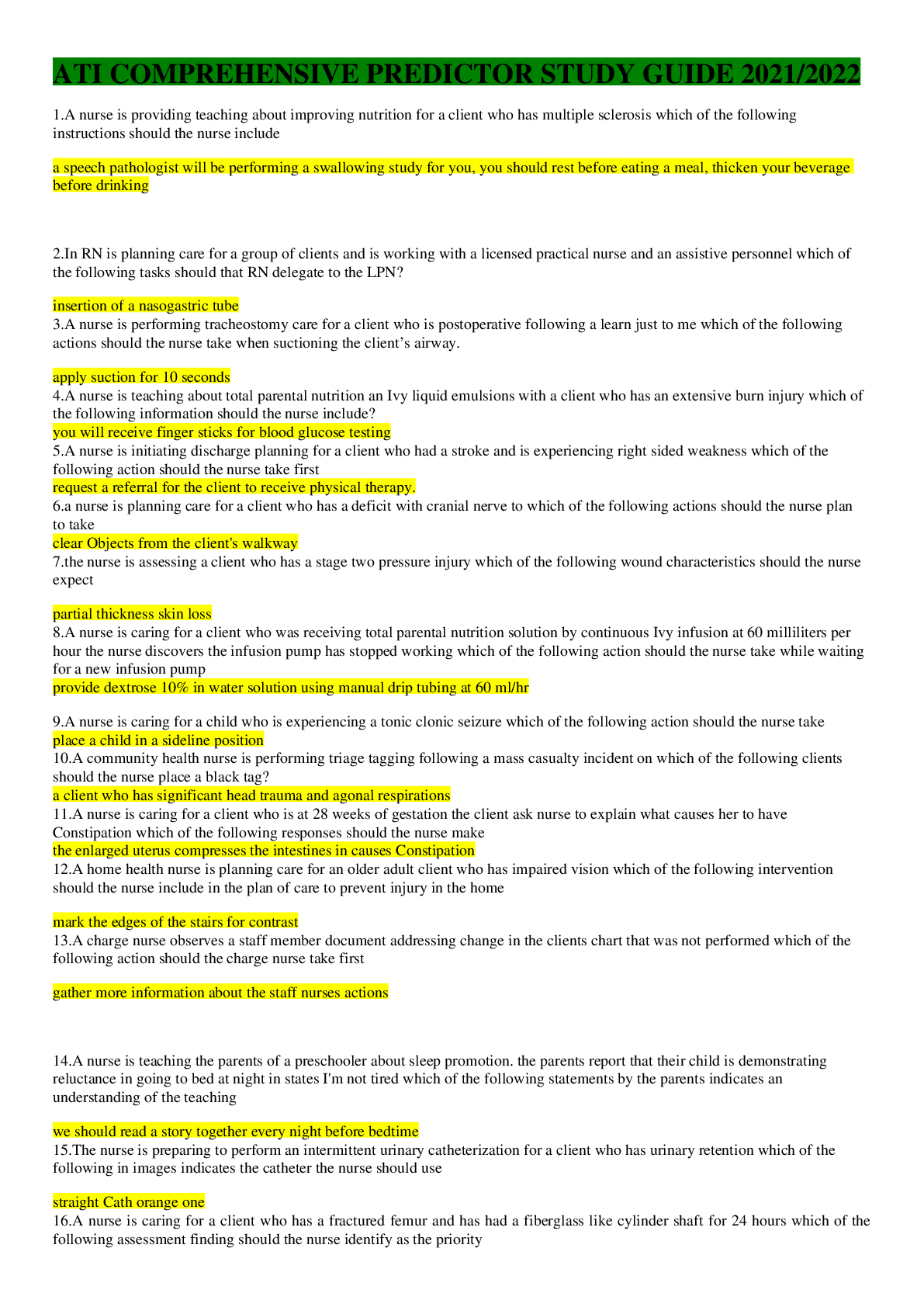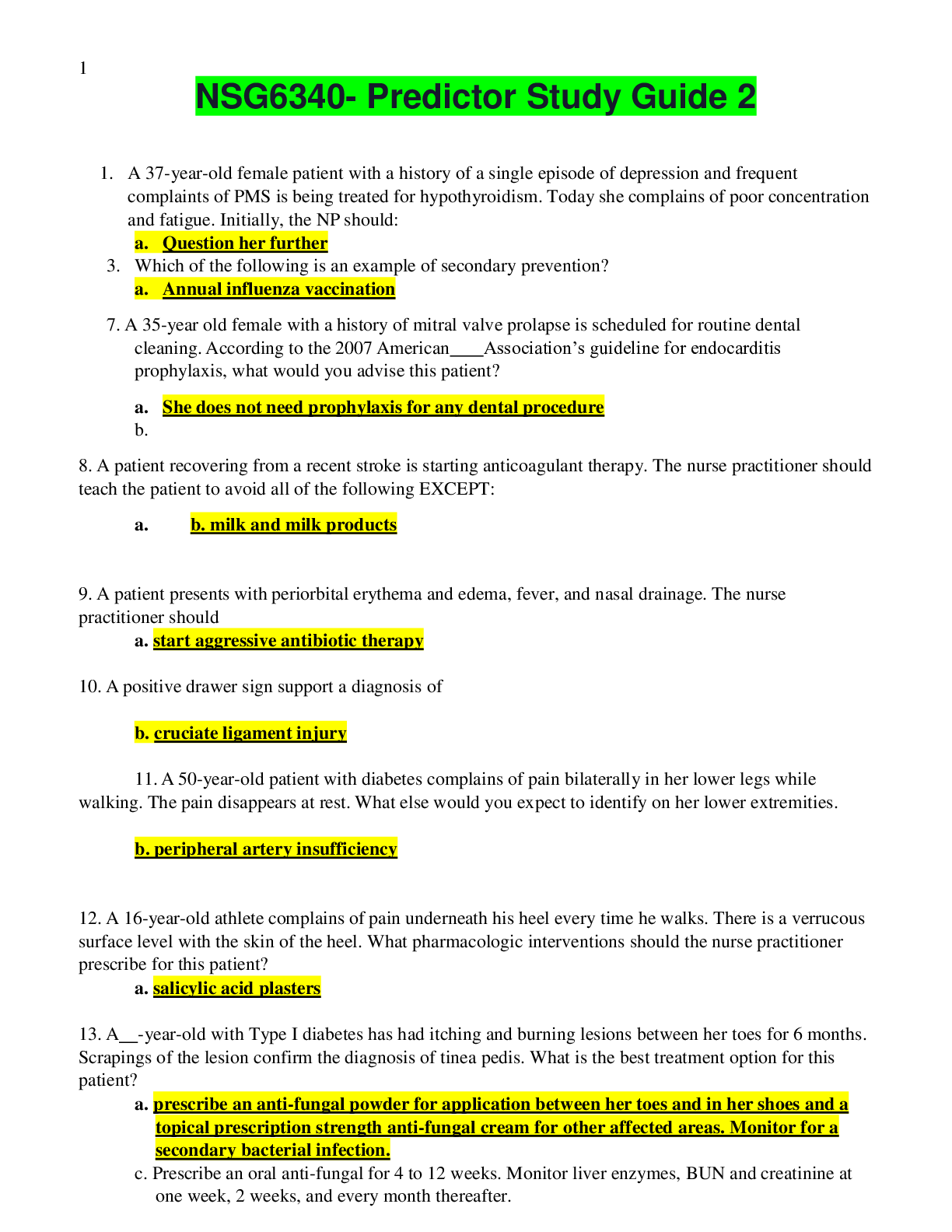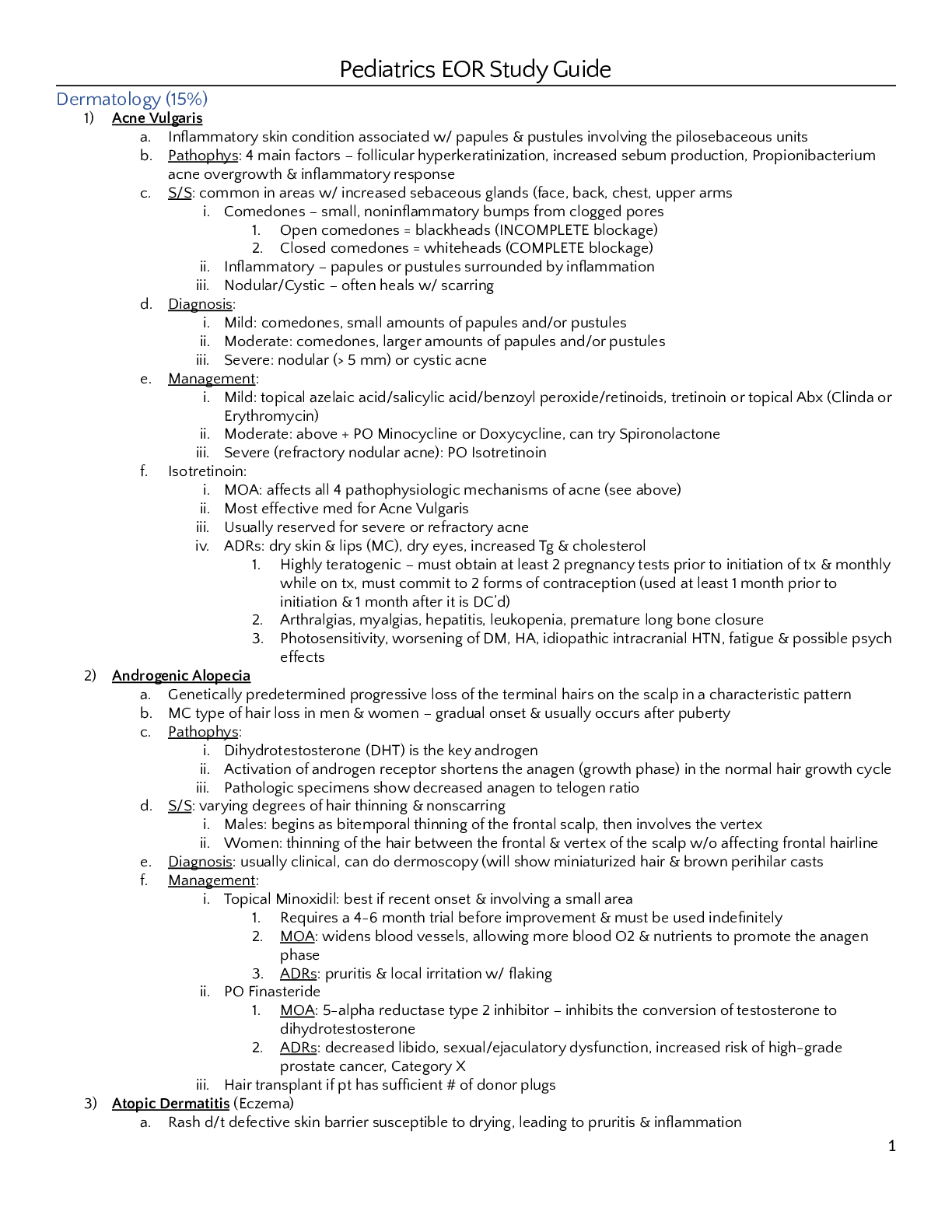Biology > STUDY GUIDE > BIO1030 - Saftey in Surgical OR Study Guide (All)
BIO1030 - Saftey in Surgical OR Study Guide
Document Content and Description Below
Safety in the Surgical Suite: Part 1: General Safety Issues Safety in OR Medical treatment facilities have a responsibility to provide a safe environment for all patients and staff members. The per... ioperative nurse must ensure that safety standards are adhered to and should continuously monitor the surgical environment to maintain safe conditions. Nurses who have worked in other areas of the hospital may be aware of basic safety concerns but be unaware of the unusual or different concerns related to the surgical environment. Facility Management's Responsibilities Each facility designates a person or committee to establish and oversee all safety practices and policies throughout the facility. The OR management team is responsible for setting up guidelines, policies, and practices that are related to safety and in accordance with regulatory agency guidelines and standards. The OR management team is responsible for: Setting and updating appropriate electrical, fire, volatile liquids, radiation, and patient management safety policies and procedures. Monitoring the overall safety of the OR environment. Monitoring and enforcing compliance with safety policies. Educating staff members about safety policies and practices. Identifying and reporting safety issues, hazards, and violations to the appropriate authorities. Department Manager’s Responsibilities Ensure that electrical devices and equipment receive timely, required maintenance. Establish an emergency plan for the event of electrical power outage. Establish a schedule and maintain documentation safety checks conducted on back-up and safety apparatus. Staff Member's Responsibilities Individual staff members play the biggest role in maintaining a safe OR environment. Staff members are required to: Know, understand, and comply with facility policies, procedures, and practices related to safety, including their facilities emergency power outage plan. Practice sound, basic and OR-specific safety. Monitor, identify, and report safety hazards. Institute of Medicine In 2000, the Institute of Medicine (IOM), Committee on Quality of Health Care in America, released the report, To Err Is Human: Building a Safer Health System. Chapter 7 of that report describes the importance of setting performance standards and expectations for patient safety. These standards and expectations apply to health care organizations, health professions, and safe use of medications and devices. The report discussed that setting standards can Establish consistency or uniformity across multiple individuals and organizations Set expectations for the organizations and health professionals affected by the standards Help set expectations for consumers and purchasers IOM Report Recommendations The IOM Report stated that "changes within health care organizations will have the most direct impact on making care delivery processes safer for patients” and recommended the following: Health care organizations, health professionals, and the Federal Drug Administration (FDA) should strengthen the focus of existing processes on patient safety issues. Health professional licensing bodies should implement periodic reexaminations and re-licensure of doctors, nurses, and other key providers. Health care licensing bodies also should develop more effective methods to identify unsafe providers and take action. Health professionals should work with certifying and professional societies to make a visible commitment to patient safety by developing permanent committees dedicated to safety improvement. The US Food and Drug Administration (FDA) should give more attention to the safe use of medications. Regulator and Accredited Influence in Patient Safety The IOM report discusses the importance of regulators and accreditors requiring health care organizations to implement meaningful patient safety programs. Being held accountable for ensuring a safe environment will motivate health care organizations to "do the right thing” for patient safety and will set an example for private purchasers and consumers in the business environment. Organizational Cultural Effect on Patient Safety Professional organizations and societies, as well as individual organizations, can proactively create a culture that supports patient safety through the following mechanisms: Set standards. Convene and communicate with members about safety. Incorporate patient safety into training programs. Collaborate across disciplines. The worker must be safe to provide safe patient care. The culture of an organization can nurture both patient safety and worker safety concepts. These organizations treat patient safety as a priority and value both the safety concepts and the people who implement the processes. An organization that does not nurture or value both patient safety and worker safety can make it difficult for the perioperative team to provide quality patient care, thereby creating higher risk for all patients. Elements of a Culture of Safety Establishing a culture of safety can bring improvements in safety and patient care overall. It changes an organization from one of "blaming" individuals for errors to one in which errors are viewed as an opportunity to improve the system and prevent harm. The four elements required to create a culture of safety are: A sense of trust among team members Dissemination and verification of receipt of information to all levels of staff and management. Page Culture of Safety elements Development and support of a proactive approach rather than a reactive, blaming approach. A sincere commitment to affirming safety as the first priority. Human Factors – Effects on Patient Safety The FDA and consumer groups have attributed many medical errors to poor device design, and manufacturers have historically identified user error as the cause of many problems. Whatever the cause, medical errors are on the rise and can be quite devastating. This is worrisome considering the national focus and demand for quality patient care. As a result, human factors impact is receiving greater attention. Perioperative nurses must understand the role of human factors in order to provide a safe patient environment. As the patient’s advocate, it is the perioperative nurse’s responsibility to understand, implement, and insist on safety for the surgical patient. Errors may be made by a simple slip or lapse in memory, or by an actual mistake. Errors can be: Issues Skill-based Errors Skill-based behavior errors generally occur when our attention is diverted and we fail to monitor the actions we are performing. Examples of this include the following: A nurse programs a new electrosurgery machine incorrectly because the sequence of steps is similar, but not identical, to the machine he or she is most familiar with. A nurse inadvertently hits the wrong control button – the correct button is near the incorrect button. A nurse forgets to retrieve a unit of blood when called to conduct a sponge count. Knowledge-based Performance Errors Rule or knowledge-based performance errors arise when a nurse misinterprets a situation or incorrectly applies a rule. Mistakes include errors in perception, judgment, inference, and interpretation. Examples of this include the following A nurse assumes the default adult dosage of 1.0 mg applies, but the current patient is a child. A nurse fails to properly assess a patient. A nurse misinterprets test results. A nurse fails to provide indicated prophylaxis. A nurse fails to respond to a device alarm. Role of Attention and Situational Factors Lack of attention and situational factors play a significant role in medical errors. Situational factors can include: Distraction (e.g., background noise, conversations, radios) Fatigue and/or sleep loss Drugs (including alcohol, and caffeine) Juggling multiple activities Stress Boredom Frustration Anxiety Anger Physical stamina due to occupational musculoskeletal injuries (e.g., back, shoulder National Patient Safety Goals Purpose The purpose of 'The Joint Commissions' National Patient Safety Goals (NPSGs) is to promote specific improvements in patient safety. 1. The Goals highlight problematic areas in health care and describe evidence and expert-based solutions to these problems. 2. Recognizing that sound system design is intrinsic to the delivery of safe, high quality health care, the Goals focus on system-wide solutions when possible. Accreditation As with The Joint Commission standards, accredited organizations are evaluated for continuous compliance with the specific requirements associated with the National Patient Safety Goals. Although these requirements are generally more prescriptive than The Joint Commission standards requirements, organizations are permitted to design alternative approaches to meeting Goal requirements and to request the Joint Commission consideration and approval of such alternatives. The Joint Commission also provides guidance on how to achieve effective compliance with each Goal’s requirements. This guidance includes detailed answers to Frequently Asked Questions (FAQs). Goal Sources The Goals are derived primarily from: Informal recommendations made in the Joint Commission's safety newsletter Sentinel Event Alert The Sentinel Event database, which contains de-identified aggregate information on sentinel events reported to the Joint Commission, is the primary, but not the sole, source of information from which the Alerts, as well as the National Patient Safety Goals, are derived. Process A broadly representative Sentinel Event Advisory Group works with Joint Commission staff on a continuing basis to determine priorities for, and develop, Goals and associated requirements. As part of this development process, candidate Goals and requirements are sent to the field for review and comment. Selected existing and new Goals and requirements are annually recommended by the Advisory Group to the Joint Commission’s Board of Commissioners for final review and approval. The Advisory Group also assists The Joint Commission in evaluating potential alternatives to Goal requirements that have been suggested by individual organizations. The purpose of 'The Joint Commission's National Patient Safety Goals (NPSGs) is to promote specific improvements in patient safety. Each of these initiatives is addressed in this safety module to help you understand how AORN recommends that health care organizations address and implement these goals. Goals are only slightly different for hospitals and ambulatory care facilities. Goal 1 - Improve the accuracy of patient identification. A. Use of the Two Patient Identifiers B. Not Applicable to Hospital C. Eliminating Transfusion Errors Goal 2 - Improve the effectiveness of communication among care givers. A. Not applicable to hospitals B. Not applicable to hospitals C. Timely Reporting of Critical Tests and Critical Results D. Not Applicable to hospitals E. Not Applicable to hospitals Goal 3 - Improve the safety of using medications. A. A., B., and C. - Not Applicable to Hospital B. Labeling Medications C. Reducing Harm from Anticoagulation Therapy * Note: Goals 4,5, and 6 are Not Applicable Goal 7 - Reduce the risk of health care-associated infections. A. Meeting Hand Hygiene Guidelines B. Not applicable to hospitals C. Preventing Multi-Drug Resistant Organism Infections D. Preventing Central-Line Associated Blood Stream Infections E. Preventing Surgical Site Infections Goal 8 - Accurately and completely reconcile medications across the continuum of care. A. Comparing Current and Newly Ordered Medications B. Communicating Medications to the Next Provider C. Providing a Reconciled Medication List to the Patient D. Setting in Which Medications are Minimally Used CC_17_Safety in the Surgical Suite – Module Summary Part 1 - General Safety Issues The Perioperative Nursing Data Set (PNDS) is a method approved in 1999 by the American Nurses Association (ANA) to document and reliably track and evaluate information to provide evidence-based practice and establish patient outcomes in the health care system. Each facility designates a person or committee to establish and oversee all safety practices and policies throughout the facility. The Institute of Medicine (IOM) report describes the importance of setting performance standards and expectations for patient safety. These standards and expectations apply to health care organizations, health professions, and safe use of medications and devices. The IOM report discusses the importance of regulators and accreditors requiring health care organizations to implement meaningful patient safety programs. Professional organizations, societies and individual organizations can proactively create a culture that supports patient safety by setting standards, convening and communicating with members about safety, incorporating patient safety into training programs, and collaborating across disciplines. The four elements required to create a culture of safety are a sense of trust among team members, dissemination and verification of receipt of information to all levels of staff and management, development and support of a proactive approach rather than a reactive, blaming approach, and a sincere commitment to affirming safety as the first priority. Errors may be made by a simple slip or lapse in memory, or by an actual mistake. Errors can be skill-based, knowledge-based or due to situational factors. Skill-based behavior errors generally occur when our attention is diverted and we fail to monitor the actions we are performing. Rule or knowledge-based performance errors arise when a nurse misinterprets a situation or incorrectly applies a rule. Lack of attention and situational factors play a significant role in medical errors. The purpose of the Joint Commission’s National Patient Safety Goals is to promote specific improvements in patient safety. The Goals highlight problematic areas in health care and describe evidence and expert-based solutions to these problems. Recognizing that sound system design is intrinsic to the delivery of safe, high quality health care, the Goals focus on system- wide solutions when possible. Part 2 – Risk Management Issues In July 2004, facilities accredited by The Joint Commission began being surveyed based on the guidelines identified in the "Universal Protocol for Preventing Wrong Site, Wrong Procedure, and Wrong Person Surgery™.” The goal is to eliminate wrong site, wrong procedure, and wrong person surgery. The protocol applies to all operative and other invasive procedures that expose patients to more than minimal risk. AORN has endorsed The Joint Commission’s "Universal Protocol for Preventing Wrong Site, Wrong Procedure, Wrong Person Surgery™” and has developed a "Correct Site Surgery Tool Kit” that details steps for implementing the Universal Protocol. This tool kit was designed to standardize the implementation of the universal protocol. Three processes to promote correct site surgery: preoperative verification, operative skin marking and Time out. The identity of the patient should be confirmed before entering the OR, before being operated on and before being transferred to another unit. Minimum two patient identifiers must be used. When marking the operative site, the operating physician/surgeon should involve the patient and marking the site with his/her initials using markers that are visible after the skin is prepped and draped. Time out should take place in the room where the procedure is to occur and should involve the entire surgical team, including the circulating nurse, scrub person, surgeon, and anesthesia care provider. Facilities should develop a consistent multidisciplinary approach for preventing retained surgical items (RSIs) that is used for all invasive procedures. All perioperative team members should be actively engaged procedures for preventing RSIs. When giving a report to the postoperative receiving unit, the perioperative nurse should give pertinent information regarding the patient's personal and medical status. Factors contributing to intraoperative injuries include preoperative skin integrity, nutritional status, preexisting metabolic dysfunction, and tissue perfusion. The perioperative nurse should assess the patient’s skin condition and allergies preoperatively and then plan the patient's care accordingly. When using positioning devices, the perioperative nurse should ensure that the devices are of the correct size, the genitalia are placed in proper anatomical position, and the positioning devices are not hurting the patient. The perioperative nurse should ensure that the electrical devices are not touching the patient's skin and the devices are being used as per the manufacturers' instructions. The perioperative nurse should also be aware of the sources of Electromagnetic Interference so as to be able to handle emergencies effectively. When working with mechanical devices, the perioperative nurse should ensure that the device does not in any way hurt the patient. When working with chemical agents, the perioperative nurse should remember to handle them safely wearing gloves and ensure that there is no spillage and unintentional injuries. Part 3 – Specific Intraoperative Risks The National Fire Protection Association (NFPA) reports that there are more than 8,000 hospital fires each year. Three elements: an ignition source, a fuel source, and an oxidizer are responsible for a fire. The perioperative nurse should be able to handle fires effectively by following R.A.C.E plan. The patient is at risk of postoperative infections, anesthetic complication and surgical/postoperative implications. The perioperative nurse should also be wary of the linen being used. Linens used in the surgical suite should be flame resistant. The perioperative nurse should be able to follow the basic electrical safety practices and ensure that the patient is not at risk from any of the devices being used. Not only should the electrical devices be used with care, but their removal should also be handled with care. An electrical power outage in the OR can have devastating consequences for patients and staff members. OR management is the responsible for devising an emergency electrical outage plan. Staff members are responsible for knowing, understanding, and complying with that plan. Facilities are required to maintain back-up power (usually a separate generator), regularly test the system, and maintain documentation pertaining to the testing and effectiveness of the back-up electrical power system. The National Fire Protection Association (NFPA) requires that ORs be equipped with a line isolation monitor. If the line isolation detection alarm sounds, the staff member should unplug the last piece of equipment in the room that was plugged in. If the alarm continues to sound, the member should begin unplugging unnecessary pieces of equipment in the room until the alarm stops. An OR member should notify facility management staff that the line isolation alarm had been activated. Electrosurgical devices have been known to cause serious patient tissue injury, as well as ignite drapes during surgical procedures. The perioperative nurse should ensure that electrosurgical units are used and handled as per the manufacturer's instructions. The perioperative nurse should be able to identify and recognize the volatile and nonvolatile liquids and agents that can cause injuries to the patient and how to handle them effectively. The perioperative nurse should also be able to handle anesthetic gases and specimen fixatives effectively and carefully. Pneumatic tourniquets frequently are used in surgery to occlude blood flow and obtain a nearly bloodless field when operating on an extremity. This bloodless field results in better visualization for the surgeon. Pneumatic tourniquets are most often used in surgery on orthopedic procedures. A tourniquet consists of a tourniquet cuff, padding, an Esmarch wrap, connective tubing, and the pressure source. Nurses should assess the patient’s entire extremity for skin integrity and cuff size before applying the tourniquet. The perioperative nurse should follow the proper cuff application procedure to ensure patient safety. The inflation time of the tourniquet should be kept to a minimum and should be recorded on the perioperative nursing record. Paralysis or nerve damage can result from prolonged use of the tourniquet. Safe tourniquet time varies with the patient’s age, physical status, and the vascular supply to the extremity. If the procedure lasts longer than the recommended inflation time limit, the tourniquet may need to be deflated to prevent nerve damage. A short deflation time (10 minutes or more) will allow oxygenated blood to return to the tissue. Potential complications from use of the pneumatic tourniquet include nerve injury, paralysis, skin blisters, abrasions, necrosis, swelling, and chemical burns. Nursing documentation for pneumatic tourniquet use should include the location of cuff; cuff pressure; skin protection; time of inflation and deflation; skin and tissue integrity under the cuff before and after the use of the pneumatic tourniquet; assessment and evaluation of the entire extremity; identification/serial number and model of the specific tourniquet unit used, and identification of the person who applied the cuff. Health care personnel working with laser equipment should demonstrate competency in the responsibilities to which they are assigned. Perioperative nurses must understand the importance of using control mechanisms to limit radiation exposure for themselves, the OR staff, and their patients. The Occupational Safety and Health Administration (OSHA) requires that Materials Safety Data Sheets (MSDSs) be developed and maintained by each facility. These documents describe all hazardous chemicals, liquids, or agents present in the facility. The MSDSs that apply to each individual work area must be immediately available in that work area. http://www.jointcommission.org/PatientSafety/NationalPatientSafetyGoals/ Page Each of these initiatives is addressed in this safety module to help you understand how AORN recommends that health care organizations address and implement these goals. Goals are only slightly different for hospitals and ambulatory care facilities. NPSGs for the current year and for the next year will be explained on the next pages. Click the buttons to learn more about the National Patient Safety Goals. The purpose of 'The Joint Commission's National Patient Safety Goals (NPSGs) is to promote specific improvements in patient safety. Safety in the Surgical Suite: Part 2: Risk Management The Joint Commission Universal Protocol Issues In July 2004, facilities accredited by The Joint Commission began being surveyed based on the guidelines identified in the "Universal Protocol for Preventing Wrong Site, Wrong Procedure, and Wrong Person Surgery™". The goal of the protocol is to eliminate wrong site, wrong procedure, and wrong person surgery The protocol applies to all operative and other invasive procedures that expose patients to more than minimal risk. The protocol includes procedures done in settings other than the OR, such as endoscopy units, emergency departments, interventional radiology units, and special procedure units. Identifying the patient Examples: Ask the patient to state their full name. Ask the patient to state their date of birth. Ask the patient to state their planned procedure and document it in the patient’s own words. Caution: The patient’s room number is NOT an acceptable patient identifier. Confirming the patient and the procedure According to AORN’s Guidelines, the patient and procedure to be performed must be confirmed and verified via the following: Patient’s name on the ID band, date of birth, and other documents that correspond with the patient’s responses Medical record number Consents These also should be confirmed: Availability of implant if required Availability of blood if ordered Radiological exams (e.g., x-ray, CT scan, MRI) Marking the Operative Site Guidelines The operative site should be marked with an indelible marker in all cases involving right/left distinction, multiple structures (like fingers and toes), or multiple levels (as in spinal cases). The marking should be at or very near the operative site and should be unambiguous (like using initials or writing YES). The marking should be visible after the patient has been prepped and draped. Using an X to mark the site may not be clear. Use a marker that is visible after the skin is prepped and draped. The markers should be FDA approved indelible markers for use on the skin. Have the operating physician/surgeon mark the site with his/her initials prior to the patient entering the OR suite. Mark the site(s) with patient participation (e.g., verbal confirmation or visual pointing). Use an additional mechanism for identifying site(s) exempt from marking according to your facility policy and The Joint Commission guidelines (such as an ID band with the procedure written on it as an alternative for marking the site). Marking the Operative Site It is crucial to involve the patient in this process. In the case of minors and unconscious or mentally incompetent adults, the parent or guardian should be involved. The operative site should be marked with an indelible marker in all cases involving right/left distinction, multiple structures (like fingers and toes), or multiple levels (as in spinal cases). The marking should be at or very near the operative site and should be unambiguous (like using initials or writing YES). The marking should be visible after the patient has been prepped and draped. X Using an X to mark the site may not be clear. Time Out The third and final step in the process is the "time-out”. This should occur immediately before the surgery or procedure starts. It should take place in the room where the procedure is to be performed and should involve the entire surgical team (circulating nurse, scrub person, surgeon, and anesthesia care provider). Active communication should be used, i.e., the process should take place verbally. "Time-out” should be briefly documented and include the patient’s identity, site and side of surgery, and verification of procedure to be performed AORN Guidelines for Time Out According to AORN standards, the patient, the procedure to be performed, and the surgical site are identified by the circulating nurse when the patient enters the OR. "Time Out” is a separate process that takes place in the OR after the patient is prepped and draped. The process involves the entire team. According to the Universal Protocol, all team members must verbally verify their agreement on the following: The name of the patient The procedure to be performed The site of the procedure, including right/left distinction Patient positioning Implants and radiological exams needed, if applicable AORN Guidelines for Documenting Time Out The following should be documented to indicate patient verification was performed as required: Correct patient Agreement on procedure Correct site and side AORN Guidelines for Time Out Discrepancies Step 1 The procedure should not begin until the patient verification and missing information are completed and agreed upon by all team members. Step 2: If a disagreement is not resolved, follow the local facility policy and notify the manager or administrator. Step 3: All issues resolved should be documented in the medical record. AORN Guidelines for Sponge, Sharp, and Instrument Counts According to AORN standards, sponge, sharp and instrument counts are critical to preventing retained surgical items (RSIs). RSIs are considered a preventable occurrence and may require public reporting. Facilities should develop a consistent multidisciplinary approach for preventing RSIs that is used for all invasive procedures. Please refer to AORN's “Recommended practice for prevention of retained surgical items.” Performing surgical item counts is one strategy to prevent RSIs, with consideration of the following A standardized approach should be used by the circulating nurse and scrub person each time a count is conducted. Counting items in the same sequence each time in a logical progression as determined by hospital policy is a standardized approach that reduces the risk of human error. Surgeons should be actively engaged in supporting the count procedure by communicating when counted items are placed in the wound, acknowledging the start of the count procedure, and performing a methodical wound exploration when counts are initiated. Anesthesia care providers should participate by planning anesthetic milestones to enable the perioperative team to conduct appropriate counts. When a discrepancy in the count is identified, the surgical team should carry out these steps: The RN circulator notifies and receives verbal acknowledgement from the surgeon and surgical team The surgeon suspends wound closure and conducts a thorough search of the wound The perioperative team performs a search of the surgical field, instrument table, count bags, and trash and linen receptacles. If the missing item is not recovered, intraoperative imaging should be performed to rule out a retained item before the final closure of the wound. Intraoperative imaging should be read by a radiologist and the results communicated directly to the surgeon. Facility policies and procedures for documentation and subsequent notifications should be followed. Conducting Patient Transfers The nursing unit staff member should notify the surgical suite staff member that the patient has arrived and is ready to be transferred to surgery. The nursing unit or preoperative nursing staff should have already obtained the patient’s medical record and reviewed it for completeness and accuracy (e.g., identification, consent form, H&P) 1. Identify the patient and surgical site, position, and procedure. 2. Visually or verbally verify that the preoperative orders and procedures have been completed (e.g., NPO status, removal of clothing, patient identification bracelet placement, special conditions due to patient allergies) 3. Reconcile any medications the patient may have been taking preoperatively or will be taking postoperatively. Transferring a Patient 1. Move the gurney as close as possible to the patient’s bed. Lock the wheels of the gurney and the bed. 2. Place a sheet or blanket over the patient. 3. Stand next to the gurney opposite the bed to prevent the patient from moving too far or not far enough onto the gurney. 4. Ask a nursing unit member to stand on the opposite side of the bed to assist with the move (unless the bed is pushed against the wall). 5. If the patient is unable to assist himself/herself in a bed-to-bed transfer, use at least four personnel to lift the patient. (Consider use of transfer devices if the patient is obese.) a. Use a draw sheet and patient transfer device (e.g., roller) to transfer the patient. b. Cross the patient’s arms across the chest. c. Roll the patient up to one side to place the transfer device. d. Gather and secure IV lines, catheters, and other apparatus so they will not be disturbed during the transfer. e. Gently roll the patient to the awaiting gurney. f. Roll the patient up to retrieve the transfer device. 6. Ensure that the patient is centered on the bed appropriately. 7. Ensure that the patient stays covered with a sheet or blanket. 8. Apply a safety strap just above the patient’s knees. 9. Pull up guard rails and unlock the gurney. 10. Push the patient feet first to the OR area. There are four reasons to push a patient feet first: a. Patients like to see where they are going. b. The "driver” can see the entire patient. c. Some patients have motion sickness when pushed facing backwards. d. When drivers push from the head of the gurney, they are able to protect the patient’s head from inadvertent injury. 11. When entering an elevator, pull the patient in head first, again, to protect the head. 12. When inside a traditional OR setting, patients should be transferred with a minimum of two staff members in attendance. 13. If patients are unable to move themselves or are combative, four staff members should be in attendance (one at the head, one at the feet, and one at each side.) 14. Also, in some ambulatory care settings, unmedicated patients may walk to and from the OR. These patients should be accompanied by at least one staff member. Documentation and Transfer of Patient Care It is crucial that perioperative nurses appropriately document and give a report to the receiving unit. When giving a report to the postoperative receiving unit, the perioperative nurse should give pertinent information regarding personal status and medical status. Medical status Patient identification Anesthesia type Anesthesia provider’s orders Surgeon’s orders Medications administered (including dosage and time) IV fluids and irrigation Advanced directives Estimated blood loss Related information about the surgical site (ie dressings, drains, packing) Vital signs Hemodynamic status Airway and oxygenation status Thermal status Urinary output Presence or absence of surgical complications Precautions (isolation, respiratory) Any significant events Patient family and/or significant other information Personal status Discomfort Comfort measures applied Patient physical, emotional and, mental status Location of family members and friends Introducing Intraoperative Risks All patients who come to surgery are at risk for skin injury. Contributing factors include preoperative skin integrity, nutritional status, preexisting metabolic dysfunction, and tissue perfusion. In the OR, we heighten the risk for skin injury to the patient by submitting the patient to: Unusual positions or positioning devices Use of electrical equipment Prolonged length of surgery Reduced tissue perfusion The use of chemical agents The perioperative nurse plays a major role in reducing and preventing intraoperative skin injuries Methods to Reduce Intraoperative Skin Injury Perioperative nurses should assess the patient’s skin condition and allergies preoperatively and accordingly plan their care. In this section, the perioperative nurse will learn a variety of ways to reduce skin injuries – from how to properly position patients to electrical safety. These methods are categorized as: 1. Positioning and positioning devices 2. Electrical/thermal equipment 3. Mechanical safety issues 4. Chemical safety concerns Using the Positioning Devices Ensure that positioning devices are the correct size for the patient. Pad bony prominence’s and relieves pressure while positioning by using gel pads, egg-crate pads, towels, etc. Protect sensitive areas such as eyes, ears, breasts, and genitalia while positioning by not dragging sheets or items over them, by padding them, and by ensuring that they are in normal anatomical position once positioning is complete. Check their position throughout the procedure. Massage heels and back of head, conduct range of motion (ROM), and reposition extremities when possible on patients enduring extensive surgical time. Ensure the patient’s skin does not inadvertently touch any metal item (e.g., part of the bed, IV pole). Ensure patient is properly secured to the OR bed with safety belt and straps Using Electrical Equipment Safely Issues when working with electrical equipment, the perioperative nurse should: Ensure that users are educated in the safe use of all electrical equipment. Ensure that active electrocautery and laser electrodes are handled and stored so they are not inadvertently discharged. Ensure that warming therapy devices (e.g., forced air heat) are used at settings appropriate for the individual patient and according to the manufacturer’s instructions. Check temperature and skin condition often. Not place electrical equipment on the patient (e.g., power equipment, ESUs). Not place the hose of a patient warmer directly under the patient's blankets, always attach intended warming blanket to hose. Handling the Implants Safely Perioperative nurses also need to be aware of patients with implantable electronic devices (IEDs) who require special safety precautions when undergoing a surgical or other invasive procedure. These include (but are not limited to) to patients having: Pacemakers Implantable cardioverter defibrillators (ICDs) Deep brain stimulators Spinal cord stimulators One especially important precaution is managing the sources of electromagnetic interference (EMI). These sources include: Electrosurgical devices Ultrasound equipment MRI equipment Mechanical Safety Issues Never place heavy instruments or equipment on the patient. Never drag the patient’s body or body parts across sheets (the weight may cause tissue shearing). Never lean on the patient, after the patient is positioned and draped, as the position may already be compromising neurovascular integrity. Ensure that towel clamps do not unintentionally puncture skin during application. Ensure that compression devices are applied properly to prevent unintentional pressure. Using Chemicals Safely Use skin preparation products according to manufacturer’s recommendations. Ensure that prep solution does not pool on the patient’s skin or on drapes under or resting on the patient. Insert blotting towels before performing the skin prep, and remove them after the prep is completed. Allow adequate time for prep solutions to dry before draping to reduce the risk associated with vapor ignition and subsequent fire. Remove prep solutions from skin post-operatively PCC_17_Safety in the Surgical Suite – Module Summary Part 1 - General Safety Issues The Perioperative Nursing Data Set (PNDS) is a method approved in 1999 by the American Nurses Association (ANA) to document and reliably track and evaluate information to provide evidence-based practice and establish patient outcomes in the health care system. Each facility designates a person or committee to establish and oversee all safety practices and policies throughout the facility. The Institute of Medicine (IOM) report describes the importance of setting performance standards and expectations for patient safety. These standards and expectations apply to health care organizations, health professions, and safe use of medications and devices. The IOM report discusses the importance of regulators and accreditors requiring health care organizations to implement meaningful patient safety programs. Professional organizations, societies and individual organizations can proactively create a culture that supports patient safety by setting standards, convening and communicating with members about safety, incorporating patient safety into training programs, and collaborating across disciplines. The four elements required to create a culture of safety are a sense of trust among team members, dissemination and verification of receipt of information to all levels of staff and management, development and support of a proactive approach rather than a reactive, blaming approach, and a sincere commitment to affirming safety as the first priority. Errors may be made by a simple slip or lapse in memory, or by an actual mistake. Errors can be skill-based, knowledge-based or due to situational factors. Skill-based behavior errors generally occur when our attention is diverted and we fail to monitor the actions we are performing. Rule or knowledge-based performance errors arise when a nurse misinterprets a situation or incorrectly applies a rule. Lack of attention and situational factors play a significant role in medical errors. The purpose of the Joint Commission’s National Patient Safety Goals is to promote specific improvements in patient safety. The Goals highlight problematic areas in health care and describe evidence and expert-based solutions to these problems. Recognizing that sound system design is intrinsic to the delivery of safe, high quality health care, the Goals focus on system- wide solutions when possible. Part 2 – Risk Management Issues In July 2004, facilities accredited by The Joint Commission began being surveyed based on the guidelines identified in the "Universal Protocol for Preventing Wrong Site, Wrong Procedure, and Wrong Person Surgery™.” The goal is to eliminate wrong site, wrong procedure, and wrong person surgery. The protocol applies to all operative and other invasive procedures that expose patients to more than minimal risk. AORN has endorsed The Joint Commission’s "Universal Protocol for Preventing Wrong Site, Wrong Procedure, Wrong Person Surgery™” and has developed a "Correct Site Surgery Tool Kit” that details steps for implementing the Universal Protocol. This tool kit was designed to standardize the implementation of the universal protocol. Three processes to promote correct site surgery: preoperative verification, operative skin marking and Time out. The identity of the patient should be confirmed before entering the OR, before being operated on and before being transferred to another unit. Minimum two patient identifiers must be used. When marking the operative site, the operating physician/surgeon should involve the patient and marking the site with his/her initials using markers that are visible after the skin is prepped and draped. Time out should take place in the room where the procedure is to occur and should involve the entire surgical team, including the circulating nurse, scrub person, surgeon, and anesthesia care provider. Facilities should develop a consistent multidisciplinary approach for preventing retained surgical items (RSIs) that is used for all invasive procedures. All perioperative team members should be actively engaged procedures for preventing RSIs. When giving a report to the postoperative receiving unit, the perioperative nurse should give pertinent information regarding the patient's personal and medical status. Factors contributing to intraoperative injuries include preoperative skin integrity, nutritional status, preexisting metabolic dysfunction, and tissue perfusion. The perioperative nurse should assess the patient’s skin condition and allergies preoperatively and then plan the patient's care accordingly. When using positioning devices, the perioperative nurse should ensure that the devices are of the correct size, the genitalia are placed in proper anatomical position, and the positioning devices are not hurting the patient. The perioperative nurse should ensure that the electrical devices are not touching the patient's skin and the devices are being used as per the manufacturers' instructions. The perioperative nurse should also be aware of the sources of Electromagnetic Interference so as to be able to handle emergencies effectively. When working with mechanical devices, the perioperative nurse should ensure that the device does not in any way hurt the patient. When working with chemical agents, the perioperative nurse should remember to handle them safely wearing gloves and ensure that there is no spillage and unintentional injuries. Part 3 – Specific Intraoperative Risks The National Fire Protection Association (NFPA) reports that there are more than 8,000 hospital fires each year. Three elements: an ignition source, a fuel source, and an oxidizer are responsible for a fire. The perioperative nurse should be able to handle fires effectively by following R.A.C.E plan. The patient is at risk of postoperative infections, anesthetic complication and surgical/postoperative implications. The perioperative nurse should also be wary of the linen being used. Linens used in the surgical suite should be flame resistant. The perioperative nurse should be able to follow the basic electrical safety practices and ensure that the patient is not at risk from any of the devices being used. Not only should the electrical devices be used with care, but their removal should also be handled with care. An electrical power outage in the OR can have devastating consequences for patients and staff members. OR management is the responsible for devising an emergency electrical outage plan. Staff members are responsible for knowing, understanding, and complying with that plan. Facilities are required to maintain back-up power (usually a separate generator), regularly test the system, and maintain documentation pertaining to the testing and effectiveness of the back-up electrical power system. The National Fire Protection Association (NFPA) requires that ORs be equipped with a line isolation monitor. If the line isolation detection alarm sounds, the staff member should unplug the last piece of equipment in the room that was plugged in. If the alarm continues to sound, the member should begin unplugging unnecessary pieces of equipment in the room until the alarm stops. An OR member should notify facility management staff that the line isolation alarm had been activated. Electrosurgical devices have been known to cause serious patient tissue injury, as well as ignite drapes during surgical procedures. The perioperative nurse should ensure that electrosurgical units are used and handled as per the manufacturer's instructions. The perioperative nurse should be able to identify and recognize the volatile and nonvolatile liquids and agents that can cause injuries to the patient and how to handle them effectively. The perioperative nurse should also be able to handle anesthetic gases and specimen fixatives effectively and carefully. Pneumatic tourniquets frequently are used in surgery to occlude blood flow and obtain a nearly bloodless field when operating on an extremity. This bloodless field results in better visualization for the surgeon. Pneumatic tourniquets are most often used in surgery on orthopedic procedures. A tourniquet consists of a tourniquet cuff, padding, an Esmarch wrap, connective tubing, and the pressure source. Nurses should assess the patient’s entire extremity for skin integrity and cuff size before applying the tourniquet. The perioperative nurse should follow the proper cuff application procedure to ensure patient safety. The inflation time of the tourniquet should be kept to a minimum and should be recorded on the perioperative nursing record. Paralysis or nerve damage can result from prolonged use of the tourniquet. Safe tourniquet time varies with the patient’s age, physical status, and the vascular supply to the extremity. If the procedure lasts longer than the recommended inflation time limit, the tourniquet may need to be deflated to prevent nerve damage. A short deflation time (10 minutes or more) will allow oxygenated blood to return to the tissue. Potential complications from use of the pneumatic tourniquet include nerve injury, paralysis, skin blisters, abrasions, necrosis, swelling, and chemical burns. Nursing documentation for pneumatic tourniquet use should include the location of cuff; cuff pressure; skin protection; time of inflation and deflation; skin and tissue integrity under the cuff before and after the use of the pneumatic tourniquet; assessment and evaluation of the entire extremity; identification/serial number and model of the specific tourniquet unit used, and identification of the person who applied the cuff. Health care personnel working with laser equipment should demonstrate competency in the responsibilities to which they are assigned. Perioperative nurses must understand the importance of using control mechanisms to limit radiation exposure for themselves, the OR staff, and their patients. The Occupational Safety and Health Administration (OSHA) requires that Materials Safety Data Sheets (MSDSs) be developed and maintained by each facility. These documents describe all hazardous chemicals, liquids, or agents present in the facility. The MSDSs that apply to each individual work area must be immediately available in that work area. Part 1 – General Safety Issues #1942, “Workplace Safety for the Perioperative Nurse” Part 2 – Risk Management Issues #1863 “Preventing Intraoperative Skin Injuries” #1945 “Safely Positioning the Surgical Patient” #1952 "Preventing Retained Surgical Items" Part 3 – Specific Intraoperative Risks #1936, “Fire Prevention in the Perioperative Suite” #1953, “Lasers Safety in the Perioperative Setting"” #1917, “Reducing Radiological Exposure” #1937, “Electrosurgery: Function, Practice and Safety Safety in the Surgical Suite: Part 3: Specific Intraoperative Risks Oxidizers: Common oxidizers include: 1. Oxygen 2. Nitrous oxide 3. Sevoflurane Ignition Sources: Common ignition sources include: 1. Electrosurgical units (ESUs) 2. Argon beam coagulators 3. Lasers 4. Fiber optic light sources and light cables 5. Power tools/drills/burrs 6. Defibrillator paddles 7. Electrical equipment Fuel Sources: Common fuel sources include: 1. Patient and staff linens 2. Prep solutions 3. Skin degreasers/ tinctures/ aerosols 4. Body tissues and patient hair 5. Intestinal gases Basic Fire Safety Facts When a fire breaks out, it breaks out fast. Within just a few minutes, a small flame can turn into a raging inferno. Following are some basic facts related to fire: è The intense heat from a fire can sear lungs and fuse clothing to the skin. è Heat rises. è Temperatures can vary from 90º F to 600º F during a fire. è Smoke contains toxic gases that can kill within minutes. è Smoke rises. It forms a dense cloud that slowly descends. If you crouch beneath the cloud, you may be able to see and breathe. è Carbon monoxide poisoning causes 75% of all fire-related deaths. Procedure for Handling a Fire on a Patient Large Flames or a Large Area Communicate the presence of the fire to team members. Communicate with the anesthesia care provider to stop the flow of breathing gases to the patient. If drapes are involved remove the drape to the ground, rolling it on itself to smother the fire. Avoid moving the drape into what may need to be the team members’ route to evacuate the room. Assess the surgical field for a secondary fire on the underlying drapes or towels. Assess the patient for injury and report injuries to a physician. Verify the flames are extinguished and use a fire extinguisher if necessary. Employ the PASS technique when using a fire extinguisher. o P = Pull o A = aim o S = squeeze o S = sweep Activate alarms if necessary. Notify the appropriate chain of command. Small Flames or a Small Area Communicate the presence of the fire to team members. Pour saline or water on the fire slowly to prevent spreading. Place your arm between the patient’s head and the fire, then lay a wet towel or sponge over the flame and sweep it toward the patient’s feet. Lift the material used to smother the flame to vent heat. Remove burning material from the patient. Assess the surgical field for a secondary fire on the underlying drapes or towels. Assess the patient for injuries and report to a physician. Activate alarms if necessary. Notify the appropriate chain of command. Small Fires Large Fires If a fire should occur; the perioperative nurse should be ready to respond quickly. Fire Safety Guidelines Apply an extinguishing agent even after the flames are out. Never leave an extinguished fire unattended. Stay until the fire department arrives. Never use elevators to escape a fire. Move patients horizontally. If you can’t move horizontally because smoke or flames block your way, proceed vertically. Work your way down to a lower level. Evacuate ambulatory patients first to reduce confusion and hallway congestion. Stay calm. Be prepared to disconnect equipment connected to patients as necessary. Have Ambu bags ready to ventilate, and use only room air (no oxygen). Know where medical gas panels and ventilation and electrical systems are located and who can shut them off. Be familiar with the location of the nearest fire extinguisher to the OR you are working in. If you catch on fire, stop, drop, and roll. At a safe area, regroup/account for all patients and staff. Never leave patients unattended. Take the patients’ medical records if possible. Have an evacuation plan posted in the surgical suite, and review it frequently. Hold routine fire drills or mock scenarios involving all members of the surgical team. Fire Safety Hazards and Practices Specific to the OR Mentally competent patients over the age of 10 should be able to follow a staff member’s directions during a fire. All other patients may need significant assistance from staff members to gain safety. A fire creates confusion and anxiety in anyone involved, therefore, most patients (and even some staff members) will need help in following appropriate evacuation and confinement procedures. Patients who are in surgery are at increased risk in the event of fire. Most anesthetized patients are unable to fend for themselves and depend solely on the knowledgeable and fast-thinking OR staff members to save their lives. These patients are not only disadvantaged from the direct effects of a fire, but also are disadvantaged from indirect hazards/risks of the fire. Indirect Fire Hazards and Risks Specific to the OR Postoperative infection Patients who must be moved because of fire are taken from the sanctity of an environmentally controlled OR through a hallway to a “safe” area. Many patients may be moved with a wound that is open, covered with a simple dressing, or packed open. These patients run a significantly increased risk of postoperative infection. Increased anesthetic complication risk If patients have to be moved during a fire, it is unlikely that all monitors, medications, life support equipment, and other supplies will be able to be moved with them. Not having commonly used equipment immediately available significantly increases the risk of, and difficulty in, managing an anesthetic complication. These patients certainly will endure longer anesthesia time, thereby increasing the opportunity for anesthetic complication. Increased surgical/postoperative complication risk Since all equipment and instrumentation may not be able to be transported with the patient, the patient is at greater risk for surgical complications. The surgical procedure may have to be aborted or interrupted and then completed later. This, too, increases the risk of surgical and postoperative complications. Certain types of equipment and supplies in the OR are known to be more fire-hazardous than others. Although these types of equipment and supplies are discussed in other modules (e.g., electrosurgical equipment, lasers, alcohol-based skin prep solutions), we will talk briefly about the main types, such as electrosurgical equipment and lasers. Click the buttons to learn about the hazards and risks specific to the surgical suite. There are some indirect hazards and risks specific to the surgical suite. Using Linens Safely Safety Another fire safety consideration is linens. Linens used in the surgical suite, such as wrappers, packages, clothing, and drapes should be flame resistant. In addition, frayed or matted linen may increase the risk of fire because fine threads provide a combustible source for a spark to catch. Never use frayed or matted linen in the surgical suite Obstructed Hallways Obstructed hallways in or near the surgical suite are one of the major hindrances to patient evacuation and the timely extinguishing of a fire. Obstructed hallways are a safety hazard. It is common to have a variety of patient gurneys, equipment, supply carts, and cleaning equipment in hallways. If equipment must be stored in the hallway, keep it all to one side only Basic Electrical Safety Facts If you have worked in other nursing areas, you know the potential harm that can occur from electrical hazards. Basic electrical safety is the same in the surgical environment as it is in all other medical treatment areas. Some of those electrical safety facts are è All electrical equipment in patient care areas should be grounded according to the requirements of the National Electrical Code. è Minimize the use of extension cords. If required, they must be evaluated by biomedical personnel before use. è Do not use "cheater adapters" (3:1 wire adapter) or alter the original configuration of a plug. è Check electrical devices, outlets, power cords and plugs before use. è Report and do not use any receptacle, cord, or plug that is loose, broken, bent, cracked, or without power. è Remove electrical cords from outlets by holding the plug, not the cord itself. è Remove from service and report any electrical equipment that malfunctions or has been dropped has had liquid spilled into it, indicates overheating by smell or touch, or gives a shocking sensation when it is touched. Electrical Safety Guidelines Ground all electrical equipment used in patient care areas as specified in Article 517 of the National Electrical Code. Minimize the use of extension cords. If required, they must be evaluated by biomedical personnel before use. Do not use "cheater adapters" (3:1 wire adapter) or alter the original configuration of a plug. Check electrical devices, outlets, power cords and plugs before use. Report and do not use any receptacle, cord, or plug that is loose, broken, bent, cracked, or without power. Remove electrical cords from outlets by holding the plug, not the cord itself. Remove from service and report any electrical equipment that malfunctions or has been dropped, has had liquid spilled into it, indicates overheating by smell or touch, or gives a shocking sensation when it is touched. Wipe up liquid spillage as soon as possible in areas where electrical equipment is in use. Arrange and secure electrical power cords to minimize the possibility of someone tripping. Avoid tightly wrapping electrical cords around equipment because this can cause cracking of the external covering and internal wires of the cord. Avoid damaging electrical cord lines by not stepping on, rolling portable equipment over, or dropping heavy objects on them. Ensure that all electrical devices to be used in a medical treatment facility are checked and cleared by biomedical personnel. Electrical Equipment The OR has a variety of specialty equipment such as warming therapy units, sequential compression devices, electrosurgical units, laser units, and complex video equipment. In addition to basic electrical safety associated with the use of medical equipment, particular attention is paid in the OR to removing from service and immediately reporting any device in which: è Controls do not produce direct or expected results è Knobs or control dials loosen or do not turn smoothly Electrical Power Outage An electrical power outage in the OR can have devastating consequences for patients and staff members. OR management is the responsible for devising an emergency electrical outage plan. Staff members are responsible for knowing, understanding, and complying with that plan. Federal regulation and safety agencies require back-up electrical power be supplied to all ORs within 10 seconds. Facilities are required to maintain back-up power (usually a separate generator), regularly test the system, and maintain documentation pertaining to the testing and effectiveness of the back-up electrical power system. In addition to back-up electrical power in the case of a power outage, ORs also plan for outages in the following ways: Identify which outlets in each OR and adjacent rooms are connected to emergency power (these outlets may be coded by having red outlet covers). Maintain battery-operated (flood) lights in each OR that come on automatically when the power to the room is cut. Maintain additional battery-operated, handheld flashlights in each OR and other patient care areas, holding areas and regional anesthesia and block rooms. Routinely check the operation and availability of back-up equipment. Maintain battery-operated or manual back-up capability for critical patient care electrical devices (e.g., suction apparatus, patient monitors, coagulation apparatus, saddle tanks for anesthetic gases and oxygen in case of loss of piped in line pressure). Maintain documentation of back-up equipment checks. Line Isolation Requirements Safety in the Surgical Suite: Part 3: Specific Intraoperative Risks Click the notepad to learn the reasons for having these monitoring and alarm systems. Reasons for having these systems Operating rooms must have their electrical power supplied by an isolated power line. An isolated power line prevents unintentional grounding of persons in contact with a live electrical cable/current. Faulty grounding can result in a burn, cardiac fibrillation, or shock to the patient or user. The National Fire Protection Association (NFPA) requires that ORs be equipped with a line isolation monitor. Monitors and alarms reduce OR hazards by continuously monitoring the electrical system. Line isolation monitors detect and alert operators when an electrical or ground leak occurs and/or when faulty equipment has been plugged into an ungrounded circuit. The NFPA requires that the grounding system be tested before use. After initial testing, the facility determines how often the system is tested. The facility maintains the test documentation as permanent records. Resolving Line Isolation Problems Power line problems Immediate actions: If the line isolation detection alarm sounds, the staff member should unplug the last piece of equipment in the room that was plugged in. If the alarm continues to sound, the member should begin unplugging unnecessary pieces of equipment in the room until the alarm stops. An OR member should notify facility management staff that the line isolation alarm had been activated. The piece of equipment in question (the one that was unplugged and made the alarm stop) should be sent to biomedical maintenance for evaluation/repair. Caution: That piece of equipment should not be used again until cleared for use by biomedical personnel. Electrical shocks Immediate actions: In case a staff member receives a shock when plugging in a piece of equipment, remove the plug from the outlet if it can be accomplished safely and if not, shut off the electrical supply at the circuit breaker then remove the plug. Caution: Staff members should use caution to avoid injury by steering clear of exposed wires, not standing in a pool of liquid, and taking other precautionary measures. Extension Cords As is true of other areas of a medical treatment facility, extension cords are discouraged in the OR. If they must be used, biomedical personnel must evaluate and clear them before use. In addition, in the OR (which is an anesthetizing location), extension cords may not be connected to lighting fixtures. Although most flammable anesthetics are no longer routinely used in the OR, a variety of other flammable liquids (e.g., those used for skin preparations) and fuel sources are present. Sparks can be caused by the placement and removal of extension cords into lighting fixtures. Sparks are extremely dangerous in areas in which flammable liquids and sprays are used Electrosurgical Safety Guidelines Place hand piece (i.e., active electrode) in an insulated, designated holder when not in use. Do not use in an oxygen-enriched environment, such as the trachea or under a sheet when oxygen is being "blown over” a patient. Allow enough time for skin preparation solutions that are flammable or contain alcohol to thoroughly dry. Place the footswitch in a place that minimizes the chance of unintentional depression. Inspect the electrosurgical unit before use. Use and reprocess instrumentation according to the manufacturer’s recommendations. Visually check the integrity and insulation of all cords and coagulation instruments before use. Ensure compatibility of instrumentation and supplies before use. Periodically clean the active electrode tip during use to prevent tissue from coating the tip. Check the entire system if it does not function properly under normal settings. Handling Volatile Agents Both volatile and nonvolatile substances may be fire hazards in the OR. In the past, agents such as acetone (used to cleanse and degrease skin) and ether (used as an anesthetic agent) were used. Today, we know these substances are highly volatile and/or highly susceptible to ignition, so most are prohibited in the OR. Commercially prepared skin degreasers, cleaning solutions, and instrument lubricants are available; therefore, we have acceptable alternatives to these hazardous chemicals. Some volatile liquids continue to be used in the OR, such as anesthetic gases and specimen fixatives. These agents are highly flammable; therefore, proper storage and usage are vital. Safety in the Surgical Suite Guidelines for Volatile Liquids A volatile liquid is a liquid that evaporates quickly. Volatile liquids in the OR cause vapors that are either hazardous to our health or are hazardous because the vapors can easily ignite. Volatile agents may be found in liquid solution or aerosol spray. Most often, volatile liquids in the OR are associated with skin preparation solutions, anesthetic gases, specimen fixatives, and lubricants. Volatile liquids are prohibited in most instances in the OR, with the exception of alcohol. Volatile Prep Solutions If a volatile or flammable prep solution is used, additional precautions must be take to minimize the risk of a surgical fire. These precautions include: Packaging these solutions in small quantities Using caution when applying to eliminate any pooling on or under body parts Removing any solution soaked materials before the patient is draped Allowing the prep solution to dry completely before applying an incise drape or surgical drape or using electrosurgery, laser or other heat source Acknowledging the use of a flammable prep agent during the time-out Disposing of unused prep solution in a safe manner, and Not heating flammable prep solutions Nonvolatile Agent Hazards Some solutions that are not volatile can still be hazardous. For example, some skin preparation solutions are not necessarily volatile but can still cause chemical irritation to the skin. Povidone-iodine prep solution is a good example. The iodine remains free until it has dried. In this form it is very irritating. If the skin is occluded before it has dried this action continues and the skin becomes macerated. Pooling of prep solutions can also cause chemical or thermal skin burns. Pooling can occur under the patient, under EKG electrodes or an ESU grounding pad. Anesthetic Gases Anesthetic gases come in liquid form. Some of these agents are known to be volatile but not flammable. Because these volatile agents are hazardous to the health of patients and staff members, great care is taken to control the use and handling of these gases. Control mechanisms are available that significantly reduce spillage while anesthetic agents are being poured. Scavenger systems reduce the waste anesthetic gas exposure to everyone in the OR. Guidelines for Specimen Fixatives Avoid splashing while pouring. Avoid skin contact by wearing gloves during handling and pouring. If skin contact occurs, wash thoroughly with water. Wear a protective mask to avoid inhaling fumes, and pour only in a well- ventilated room or under a flow hood. Wear protective goggles to avoid eye contact. If eye contact occurs, flush immediately and thoroughly with water before getting medical attention. Triple-rinse with water any area or surface where accidental formalin spillage occurs. Store in a dedicated area away from medications, sterile supplies, and food supplies. Store fixatives securely so they are inaccessible to persons unfamiliar with their proper use Pneumatic Tourniquet Equipment Pneumatic tourniquets are most often used in surgery on orthopedic procedures. After determining that a tourniquet will be used on the patient, the nurse needs to gather the necessary equipment for tourniquet application. The equipment needed will include: Tourniquet cuff Padding (usually stockinette) Esmarch wrap Connective tubing Pressure source An Esmarch is an elastic wrap placed distally on the extremity and wrapped circumferentially to the proximal portion of the extremity in order to push the blood from the extremity. This often is done before inflating the pneumatic tourniquet. Surgeries that may require tourniquets Hand, wrist, or elbow surgery, such as carpal tunnel release, repair of fractured wrist, and ulnar nerve transposition. Knee, ankle, or foot surgery, such as knee arthroscopy, total knee arthroplasty, repair of ankle fracture, and Morton's Neuroma. Tourniquet Cuffs Preoperatively, nurses should assess the patient’s entire extremity for skin and tissue integrity before applying the tourniquet. This is also the time to estimate what size of tourniquet cuff will be needed. Tourniquet cuffs come in different sizes: • 12 in., 18 in. - usually for arms on adults and pediatric patients • 24 in., 34 in., 42 in. - usually for legs The cuff length ideally should overlap at least 3 inches, with a maximum of 6 inches Testing the Tourniquet Cuff Pneumatic tourniquets should be tested before use. Facility policy and manufacturer’s written guidelines on tourniquet testing should be followed. Periodic testing ensures that the tourniquet is functioning properly. The cuff and tubing should be inspected for cracks and leaks. Many pneumatic tourniquets which have been recently manufactured have a pre-programmed self-test that automatically occurs each time the tourniquet is turned on. Be certain this self-test occurs before each episode of tourniquet use. Applying a Tourniquet 1. Elevate the extremity. 2. Apply padding (cast padding or stockinette) around the extremity at the most proximal point. Two layers is adequate. Care should be taken to eliminate any wrinkles or creases. 3. Grasp the cuff with two hands, pull, and secure the cuff around the extremity. 4. Attach the tubing from the automatic pressure device. 5. Be sure to locate connectors for tubing in a convenient place where they will not get kinked. Maintaining the Cuff Pressure An Esmarch wrap may be applied at this point if the surgeon so desires. Then the tourniquet is inflated. The surgeon specifies the tourniquet setting, considering the patient’s age and systolic blood pressure, circumference of the extremity, tourniquet width, and other clinical factors. The exact cuff pressure to set for inflation has not been determined. As a guideline, the minimum pressure that will create a bloodless field should be used. Inflation time Inflation time of the tourniquet should be kept to a minimum. Inflation pressure and time are recorded on the perioperative nursing record. The surgeon should be made aware of duration of tourniquet time at regular time intervals – usually one hour for upper extremities and one and one half hours for lower extremities. Paralysis or nerve damage can result from prolonged use of the tourniquet. Safe tourniquet time varies with the patient’s age, physical status, and the vascular supply to the extremity Deflating the cuffs If the procedure lasts longer than the recommended inflation time limit, the tourniquet may need to be deflated to prevent nerve damage. The extremity should be elevated and wrapped with an elastic bandage before deflation. A short deflation time (10 minutes or more) will allow oxygenated blood to return to the tissue. An Esmarch wrap may be applied. The tourniquet may be reinflated for another full period Cleaning the Tourniquet When the incision has been closed and the dressing has been applied, the tourniquet can be deflated upon the instructions of the surgeon. After the tourniquet has been used, the cuff and bladder should be cleaned, rinsed, and dried according to the manufacturer’s instructions. Disposable single-use tourniquet cuffs should be discarded. All connecting tubing should be wiped with a US Environmental Protection Agency (EPA) high-level or intermediate-level tuberculocidal disinfectant and dried before storage Tourniquet Complications Potential complications from use of the pneumatic tourniquet include nerve injury, paralysis, skin blisters, abrasions, necrosis, swelling, and chemical burns. Nerve injury and paralysis can result from prolonged use of the tourniquet. Chemical burns and other skin injuries can occur when prepping solution is allowed to pool under the tourniquet cuff. To prevent these complications, safety measures should be followed. Safety measures to prevent complications or injury should include: Complete preoperative patient assessment. Ensure proper fit of the cuff. Follow guidelines for testing the tourniquet. Apply cuff to the limb with care and attention. Keep fluids, such as skin prep solutions and irrigation, from pooling under the cuff. These fluids may cause skin injury due to chemical burns. Monitor inflation time. Monitor pressure display to ensure it accurately reflects the pressure within the cuff bladder. Only use the minimal effective pressure to create a bloodless field. Follow manufacturer’s written directions. Tourniquet Documentation Location of cuff Cuff pressure Skin protection (e.g., padding) Time of inflation and deflation Skin and tissue integrity under the cuff before and after the use of the pneumatic tourniquet Assessment and evaluation of the entire extremity Identification/serial number and model of the specific tourniquet Identification of the person who applied the cuff Bier Block Technique 1. A double-cuffed tourniquet is applied to the upper extremity. 2. The extremity is elevated and exsanguinated. 3. The proximal tourniquet cuff is inflated. 4. A local anesthetic, usually lidocaine is injected. The local anesthetic infiltrates and is limited to the tissues that are distal to the tourniquet. 5. In order to ease tourniquet pain, the second (distal) cuff may be inflated and the first (proximal) cuff deflated after the anesthetic has had time to take effect. Laser Safety Overview Many different types of lasers are used in the health care setting. The use of lasers can present a serious fire hazard. A laser beam directed at combustible or flammable materials can ignite within a few seconds potentially causing serious injury to the patient or health care personnel. Because of this serious hazard, perioperative personnel must adhere to a variety of safety practices when operating laser equipment. The perioperative team is responsible for ensuring that both patients and staff are adequately protected from hazards such as: Eye injuries Tissue burns Plume inhalation Fire hazards Reflection or inadvertent beam exposure Electrical hazards Laser safety can be facilitated through the development and enforcement of laser controls throughout the health care organization Guidelines for the Safe Handling of Lasers è The laser operator should have no competing responsibilities. è The laser operator should place the laser in standby mode when the laser is not in active use. è Personnel working with laser equipment should demonstrate competency in the responsibilities that they are assigned. è Cover room windows when argon, KTP, Nd: YAG, or other color-dependent lasers are being used, so stray beams cannot be transmitted through the window. è Appropriate protective eyewear must be worn by everyone who is present in the nominal hazard zone. è Appropriate eyewear is inscribed with the laser wavelength and optical density for the laser in use. Prescription eyewear is not appropriate protective eyewear for use in rooms where lasers are in use. è Use appropriate eyewear inscribed with the laser wavelength and optical density. è Provide an additional pair of appropriate laser wavelength-specific eyewear on the outside door for individuals needing access into the room. è Post visual signs on all room entrances when lasers are being used and remove them when the procedure is finished. è Allow skin preparations to thoroughly dry that are flammable or contain alcohol. è Use ignition resistant drapes during laser procedures. è Moisten exposed tissue and drape edges to reduce combustion hazard and tissue damage at the operative site (remoisten throughout case). è Use nonreflective or ebonized instruments when positioning them near the laser-impact site during laser surgery. è Keep a labeled basin of sterile water on the surgical field throughout the case to douse a fire. è Have an appropriate fire extinguisher immediately available in case of fire. è Use a laser-safe endotracheal tube (with a cuff inflated with saline and methylene blue dye) when using a laser in or near the aerodigestive tract. è Remove the laser from service and have entire system checked if the laser does not function properly under normal settings. è Ensure compatibility of instrumentation and supplies before use. For example, do not use flammable instruments, such as plastic speculae, near a CO2 laser beam. Do not use glass rod backstops with CO2 lasers. Use quartz or titanium rods for safe backstops. è Evacuate all surgical smoke using an appropriate smoke evacuation method. è When placing a fiber or hand piece on drapes when not in use, cover with a wet towel. è Use and reprocess instrumentation and equipment according to manufacturer's instructions. The Nominal Hazard Zone (NHZ) The nominal hazard zone (NHZ) is the space where the level of direct, reflected, or scattered laser light exceeds the maximum permissible exposure (MPE) level for specific laser. Access to the laser treatment area should be limited to appropriately educate health care personnel. Within the nominal hazard zone: • Appropriate eye protection must be worn • Appropriate skin protection must be used. • All health care personnel should be aware of all laser safety precautions. In the interest of standardization, most facilities consider the entire procedure room the NHZ, no matter what laser is being used Radiation Safety Overview Radiation exposure can be hazardous to our health. Depending on the type, length, and dose of exposure, it can cause a wide range of injuries from an acute, localized skin redness to permanent injury or illness. The Nuclear Regulatory Commission believes that radiation exposure should be as low as reasonably achievable (ALARA) or as low as possible. Perioperative nurses must understand the importance of using control mechanisms to limit radiation exposure for themselves, the OR staff, and their patients. Radiation Safety Guidelines Nonessential personnel (anyone not required to provide immediate patient care) should leave the room or maintain a safe distance behind a lead screen while x-rays are being taken. All personnel should wear protective devices such as lead aprons, gloves, and thyroid collars during exposure time. Pregnant personnel should avoid or limit radiation exposure. When surgical team members are made aware of potentially prolonged exposure times, they should wear lead aprons throughout the case. Film badges that measure radiation exposure may be used for those staff members who have prolonged or frequent exposure. Education on radiation exposure should be provided to all OR team members so they understand and practice radiation safety Materials Safety Data Sheets The Occupational Safety and Health Administration (OSHA) require that Materials Safety Data Sheets (MSDSs) be developed and maintained by the facility. These documents describe all hazardous chemicals, liquids, or agents present in the facility. The MSDSs that apply to each individual work area must be immediately available in that work area. The MSDS describes the individual hazardous chemical, liquid, or agent, gives user information about the appropriate use and handling of that agent, and provides the user with post exposure information and actions. Employers are required to have the MSDSs immediately available to employees, understand the purposes and use of the MSDSs, and ensure that employees know where they are located. Additional Safety Risks Other practices, issues, and concerns can place the patient at risk in the OR. Some of those risks include: Infection resulting from poor aseptic technique Retained foreign bodies Safety hazards associated with the use of sterilization units and chemical disinfectants Patient preoperative health status Injuries in the Surgical Suite You've carefully thought out all the angles. You've done it a thousand times. It comes naturally to you. You know what you're doing - it's what you've been trained to do your whole life. Could anything possibly go wrong? PCC_17_Safety in the Surgical Suite – Module Summary Part 1 - General Safety Issues The Perioperative Nursing Data Set (PNDS) is a method approved in 1999 by the American Nurses Association (ANA) to document and reliably track and evaluate information to provide evidence-based practice and establish patient outcomes in the health care system. Each facility designates a person or committee to establish and oversee all safety practices and policies throughout the facility. The Institute of Medicine (IOM) report describes the importance of setting performance standards and expectations for patient safety. These standards and expectations apply to health care organizations, health professions, and safe use of medications and devices. The IOM report discusses the importance of regulators and accreditors requiring health care organizations to implement meaningful patient safety programs. Professional organizations, societies and individual organizations can proactively create a culture that supports patient safety by setting standards, convening and communicating with members about safety, incorporating patient safety into training programs, and collaborating across disciplines. The four elements required to create a culture of safety are a sense of trust among team members, dissemination and verification of receipt of information to all levels of staff and management, development and support of a proactive approach rather than a reactive, blaming approach, and a sincere commitment to affirming safety as the first priority. Errors may be made by a simple slip or lapse in memory, or by an actual mistake. Errors can be skill-based, knowledge-based or due to situational factors. Skill-based behavior errors generally occur when our attention is diverted and we fail to monitor the actions we are performing. Rule or knowledge-based performance errors arise when a nurse misinterprets a situation or incorrectly applies a rule. Lack of attention and situational factors play a significant role in medical errors. The purpose of the Joint Commission’s National Patient Safety Goals is to promote specific improvements in patient safety. The Goals highlight problematic areas in health care and describe evidence and expert-based solutions to these problems. Recognizing that sound system design is intrinsic to the delivery of safe, high quality health care, the Goals focus on system- wide solutions when possible. Part 2 – Risk Management Issues In July 2004, facilities accredited by The Joint Commission began being surveyed based on the guidelines identified in the "Universal Protocol for Preventing Wrong Site, Wrong Procedure, and Wrong Person Surgery™.” The goal is to eliminate wrong site, wrong procedure, and wrong person surgery. The protocol applies to all operative and other invasive procedures that expose patients to more than minimal risk. AORN has endorsed The Joint Commission’s "Universal Protocol for Preventing Wrong Site, Wrong Procedure, Wrong Person Surgery™” and has developed a "Correct Site Surgery Tool Kit” that details steps for implementing the Universal Protocol. This tool kit was designed to standardize the implementation of the universal protocol. Three processes to promote correct site surgery: preoperative verification, operative skin marking and Time out. The identity of the patient should be confirmed before entering the OR, before being operated on and before being transferred to another unit. Minimum two patient identifiers must be used. When marking the operative site, the operating physician/surgeon should involve the patient and marking the site with his/her initials using markers that are visible after the skin is prepped and draped. Time out should take place in the room where the procedure is to occur and should involve the entire surgical team, including the circulating nurse, scrub person, surgeon, and anesthesia care provider. Facilities should develop a consistent multidisciplinary approach for preventing retained surgical items (RSIs) that is used for all invasive procedures. All perioperative team members should be actively engaged procedures for preventing RSIs. When giving a report to the postoperative receiving unit, the perioperative nurse should give pertinent information regarding the patient's personal and medical status. Factors contributing to intraoperative injuries include preoperative skin integrity, nutritional status, preexisting metabolic dysfunction, and tissue perfusion. The perioperative nurse should assess the patient’s skin condition and allergies preoperatively and then plan the patient's care accordingly. When using positioning devices, the perioperative nurse should ensure that the devices are of the correct size, the genitalia are placed in proper anatomical position, and the positioning devices are not hurting the patient. The perioperative nurse should ensure that the electrical devices are not touching the patient's skin and the devices are being used as per the manufacturers' instructions. The perioperative nurse should also be aware of the sources of Electromagnetic Interference so as to be able to handle emergencies effectively. Summary Part 3 The National Fire Protection Association (NFPA) reports that there are more than 8,000 hospital fires each year. Three elements: an ignition source, a fuel source, and an oxidizer are responsible for a fire. The perioperative nurse should be able to handle fires effectively by following R.A.C.E plan. The patient is at risk of postoperative infections, anesthetic complication and surgical/postoperative implications. The perioperative nurse should also be wary of the linen being used. Linens used in the surgical suite should be flame resistant. The perioperative nurse should be able to follow the basic electrical safety practices and ensure that the patient is not at risk from any of the devices being used. Not only should the electrical devices be used with care, but their removal should also be handled with care. An electrical power outage in the OR can have devastating consequences for patients and staff members. OR management is the responsible for devising an emergency electrical outage plan. Staff members are responsible for knowing, understanding, and complying with that plan. Facilities are required to maintain back-up power (usually a separate generator), regularly test the system, and maintain documentation pertaining to the testing and effectiveness of the back-up electrical power system. The National Fire Protection Association (NFPA) requires that ORs be equipped with a line isolation monitor in all new facilities and a ground detection alarm in older facilities. If the line isolation detection alarm sounds, the staff member should unplug the last piece of equipment in the room that was plugged in. If the alarm continues to sound, the member should begin unplugging unnecessary pieces of equipment in the room until the alarm stops. An OR member should notify facility management staff that the line isolation alarm had been activated. Electrosurgical devices have been known to cause serious patient tissue injury, as well as ignite drapes during surgical procedures. The perioperative nurse should ensure that electrosurgical units are used and handled as per the manufacturer's instructions. The perioperative nurse should be able to identify and recognize the volatile and nonvolatile liquids and agents that can cause injuries to the patient and how to handle them effectively. The perioperative nurse should also be able to handle anesthetic gases and specimen fixatives effectively and carefully. Pneumatic tourniquets frequently are used in surgery to occlude blood flow and obtain a nearly bloodless field when operating on an extremity. This bloodless field results in better visualization for the surgeon. Pneumatic tourniquets are most often used in surgery on orthopedic procedures. A tourniquet consists of a tourniquet cuff, padding, an Esmarch wrap, connective tubing, and the pressure source. Nurses should assess the patient’s entire extremity for skin integrity and cuff size before applying the tourniquet. The perioperative nurse should follow the proper cuff application procedure to ensure patient safety. The inflation time of the tourniquet should be kept to a minimum and should be recorded on the perioperative nursing record. Paralysis or nerve damage can result from prolonged use of the tourniquet. Safe tourniquet time varies with the patient’s age, physical status, and the vascular supply to the extremity. If the procedure lasts longer than the recommended inflation time limit, the tourniquet may need to be deflated to prevent nerve damage. A short deflation time (10 minutes or more) will allow oxygenated blood to return to the tissue. Potential complications from use of the pneumatic tourniquet include nerve injury, paralysis, skin blisters, abrasions, necrosis, swelling, and chemical burns. Nursing documentation for pneumatic tourniquet use should include the location of cuff; cuff pressure; skin protection; time of inflation and deflation; skin and tissue integrity under the cuff before and after the use of the pneumatic tourniquet; assessment and evaluation of the entire\ extremity; identification/serial number and model of the specific tourniquet unit used, and identification of the person who applied the cuff. Health care personnel working with laser equipment should demonstrate competency in the responsibilities to which they are assigned. Perioperative nurses must understand the importance of using control mechanisms to limit radiation exposure for themselves, the OR staff, their patients. The Occupational Safety and Health Administration (OSHA) require that Materials Safety Data Sheets (MSDSs) be developed and maintained by each facility. These documents describe all hazardous chemicals, liquids, or agents present in the facility. The MSDSs that apply to each individual work area must be immediately available in that work area. [Show More]
Last updated: 2 years ago
Preview 1 out of 43 pages
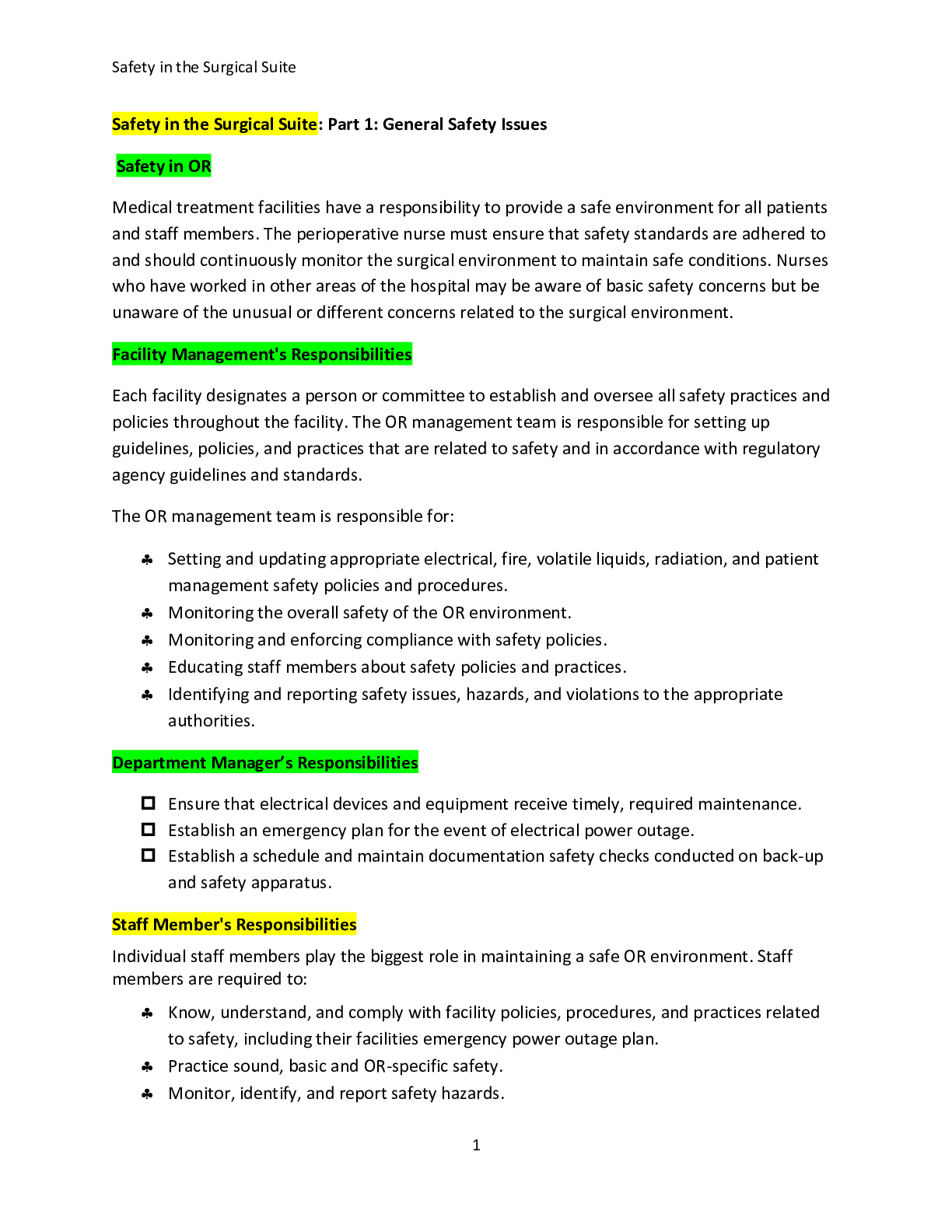
Buy this document to get the full access instantly
Instant Download Access after purchase
Buy NowInstant download
We Accept:

Reviews( 0 )
$17.00
Can't find what you want? Try our AI powered Search
Document information
Connected school, study & course
About the document
Uploaded On
Dec 16, 2020
Number of pages
43
Written in
Additional information
This document has been written for:
Uploaded
Dec 16, 2020
Downloads
0
Views
90



